Impact of Employee Motivation Schemes on Satisfaction and Retention of Staff Members: A Study on Sainsbury's
VerifiedAdded on 2023/06/13
|27
|5841
|469
AI Summary
This research examines the impact of employee motivation schemes on satisfaction and retention of staff members in Sainsbury's. It explores the challenges faced by Sainsbury's in executing employee motivation strategies and the strategies adopted by the company. The research methodology includes a quantitative approach with the use of a survey and questionnaire. The research philosophy is epistemology.
Contribute Materials
Your contribution can guide someone’s learning journey. Share your
documents today.
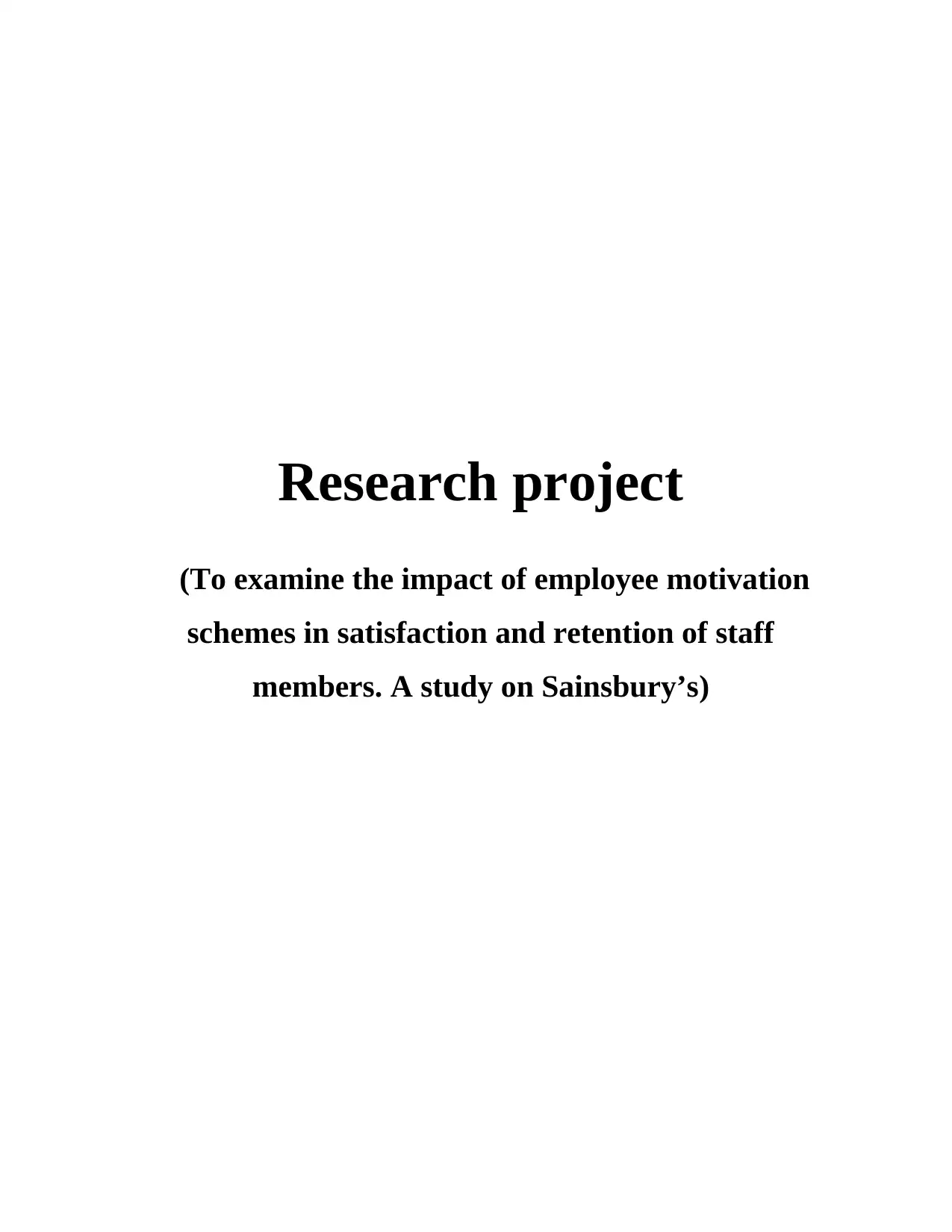
Research project
(To examine the impact of employee motivation
schemes in satisfaction and retention of staff
members. A study on Sainsbury’s)
(To examine the impact of employee motivation
schemes in satisfaction and retention of staff
members. A study on Sainsbury’s)
Secure Best Marks with AI Grader
Need help grading? Try our AI Grader for instant feedback on your assignments.
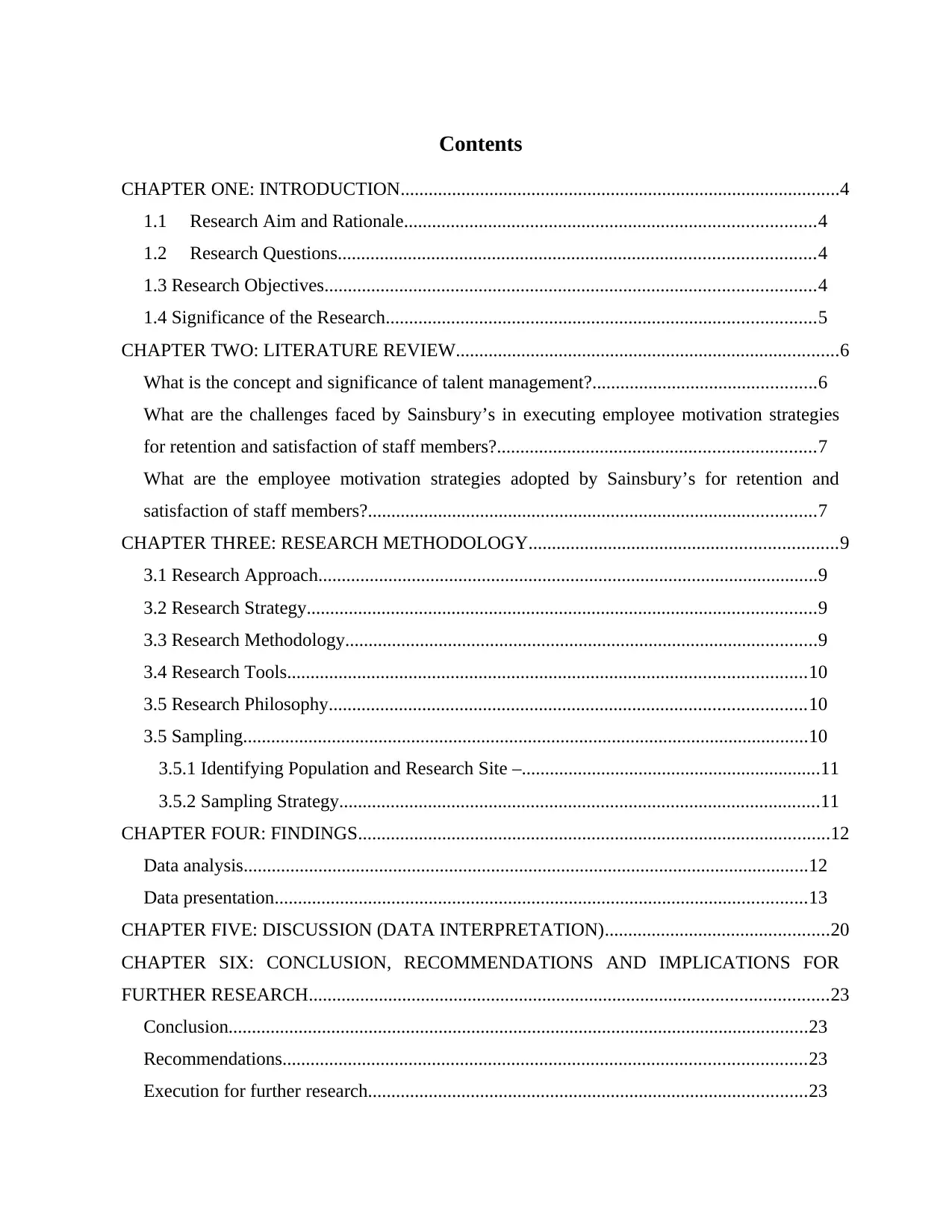
Contents
CHAPTER ONE: INTRODUCTION..............................................................................................4
1.1 Research Aim and Rationale........................................................................................4
1.2 Research Questions......................................................................................................4
1.3 Research Objectives.........................................................................................................4
1.4 Significance of the Research............................................................................................5
CHAPTER TWO: LITERATURE REVIEW..................................................................................6
What is the concept and significance of talent management?................................................6
What are the challenges faced by Sainsbury’s in executing employee motivation strategies
for retention and satisfaction of staff members?....................................................................7
What are the employee motivation strategies adopted by Sainsbury’s for retention and
satisfaction of staff members?................................................................................................7
CHAPTER THREE: RESEARCH METHODOLOGY..................................................................9
3.1 Research Approach...........................................................................................................9
3.2 Research Strategy.............................................................................................................9
3.3 Research Methodology.....................................................................................................9
3.4 Research Tools...............................................................................................................10
3.5 Research Philosophy......................................................................................................10
3.5 Sampling.........................................................................................................................10
3.5.1 Identifying Population and Research Site –................................................................11
3.5.2 Sampling Strategy.......................................................................................................11
CHAPTER FOUR: FINDINGS.....................................................................................................12
Data analysis.........................................................................................................................12
Data presentation..................................................................................................................13
CHAPTER FIVE: DISCUSSION (DATA INTERPRETATION)................................................20
CHAPTER SIX: CONCLUSION, RECOMMENDATIONS AND IMPLICATIONS FOR
FURTHER RESEARCH...............................................................................................................23
Conclusion............................................................................................................................23
Recommendations................................................................................................................23
Execution for further research..............................................................................................23
CHAPTER ONE: INTRODUCTION..............................................................................................4
1.1 Research Aim and Rationale........................................................................................4
1.2 Research Questions......................................................................................................4
1.3 Research Objectives.........................................................................................................4
1.4 Significance of the Research............................................................................................5
CHAPTER TWO: LITERATURE REVIEW..................................................................................6
What is the concept and significance of talent management?................................................6
What are the challenges faced by Sainsbury’s in executing employee motivation strategies
for retention and satisfaction of staff members?....................................................................7
What are the employee motivation strategies adopted by Sainsbury’s for retention and
satisfaction of staff members?................................................................................................7
CHAPTER THREE: RESEARCH METHODOLOGY..................................................................9
3.1 Research Approach...........................................................................................................9
3.2 Research Strategy.............................................................................................................9
3.3 Research Methodology.....................................................................................................9
3.4 Research Tools...............................................................................................................10
3.5 Research Philosophy......................................................................................................10
3.5 Sampling.........................................................................................................................10
3.5.1 Identifying Population and Research Site –................................................................11
3.5.2 Sampling Strategy.......................................................................................................11
CHAPTER FOUR: FINDINGS.....................................................................................................12
Data analysis.........................................................................................................................12
Data presentation..................................................................................................................13
CHAPTER FIVE: DISCUSSION (DATA INTERPRETATION)................................................20
CHAPTER SIX: CONCLUSION, RECOMMENDATIONS AND IMPLICATIONS FOR
FURTHER RESEARCH...............................................................................................................23
Conclusion............................................................................................................................23
Recommendations................................................................................................................23
Execution for further research..............................................................................................23

REFERENCES..............................................................................................................................25
APPENDIX....................................................................................................................................26
Questionnaire........................................................................................................................26
APPENDIX....................................................................................................................................26
Questionnaire........................................................................................................................26
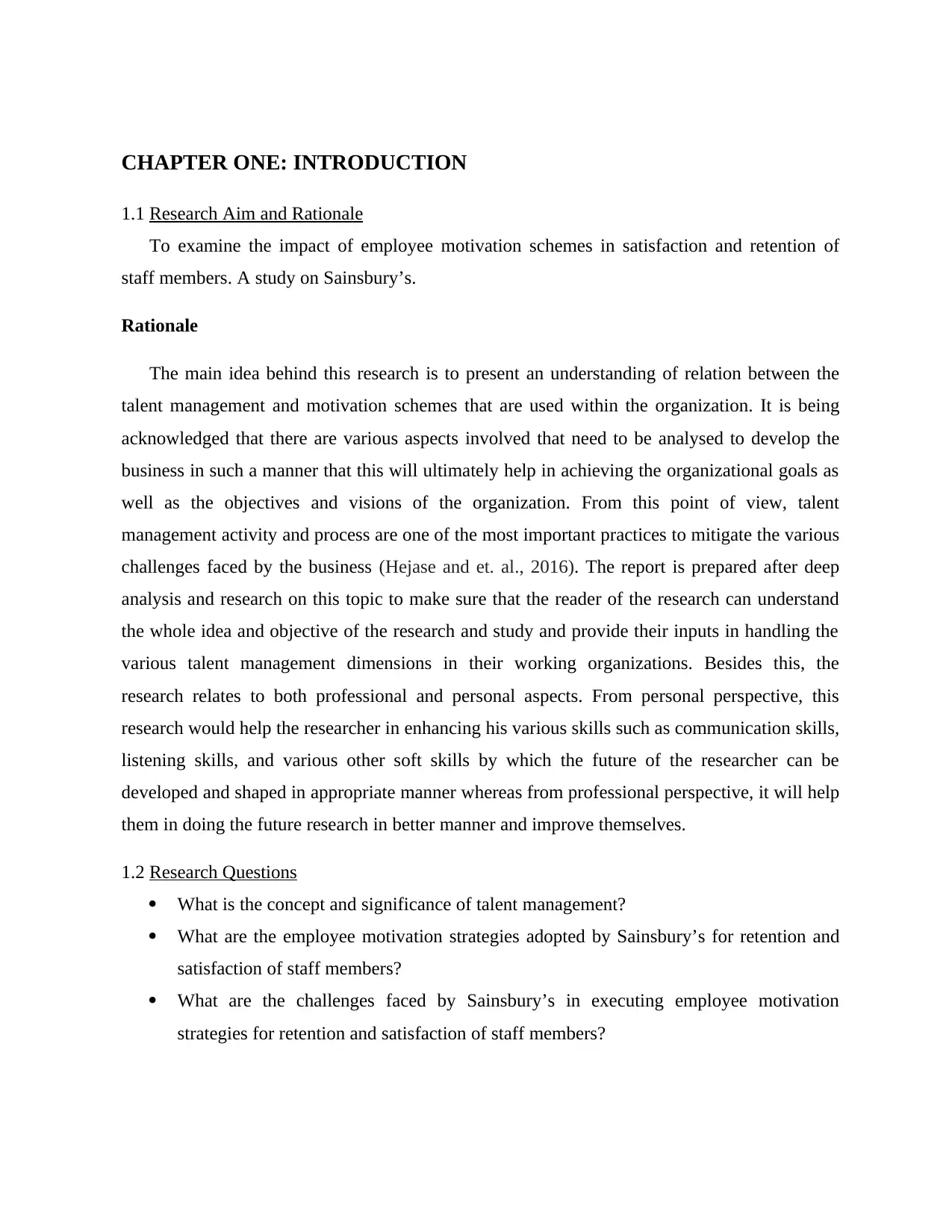
CHAPTER ONE: INTRODUCTION
1.1 Research Aim and Rationale
To examine the impact of employee motivation schemes in satisfaction and retention of
staff members. A study on Sainsbury’s.
Rationale
The main idea behind this research is to present an understanding of relation between the
talent management and motivation schemes that are used within the organization. It is being
acknowledged that there are various aspects involved that need to be analysed to develop the
business in such a manner that this will ultimately help in achieving the organizational goals as
well as the objectives and visions of the organization. From this point of view, talent
management activity and process are one of the most important practices to mitigate the various
challenges faced by the business (Hejase and et. al., 2016). The report is prepared after deep
analysis and research on this topic to make sure that the reader of the research can understand
the whole idea and objective of the research and study and provide their inputs in handling the
various talent management dimensions in their working organizations. Besides this, the
research relates to both professional and personal aspects. From personal perspective, this
research would help the researcher in enhancing his various skills such as communication skills,
listening skills, and various other soft skills by which the future of the researcher can be
developed and shaped in appropriate manner whereas from professional perspective, it will help
them in doing the future research in better manner and improve themselves.
1.2 Research Questions
What is the concept and significance of talent management?
What are the employee motivation strategies adopted by Sainsbury’s for retention and
satisfaction of staff members?
What are the challenges faced by Sainsbury’s in executing employee motivation
strategies for retention and satisfaction of staff members?
1.1 Research Aim and Rationale
To examine the impact of employee motivation schemes in satisfaction and retention of
staff members. A study on Sainsbury’s.
Rationale
The main idea behind this research is to present an understanding of relation between the
talent management and motivation schemes that are used within the organization. It is being
acknowledged that there are various aspects involved that need to be analysed to develop the
business in such a manner that this will ultimately help in achieving the organizational goals as
well as the objectives and visions of the organization. From this point of view, talent
management activity and process are one of the most important practices to mitigate the various
challenges faced by the business (Hejase and et. al., 2016). The report is prepared after deep
analysis and research on this topic to make sure that the reader of the research can understand
the whole idea and objective of the research and study and provide their inputs in handling the
various talent management dimensions in their working organizations. Besides this, the
research relates to both professional and personal aspects. From personal perspective, this
research would help the researcher in enhancing his various skills such as communication skills,
listening skills, and various other soft skills by which the future of the researcher can be
developed and shaped in appropriate manner whereas from professional perspective, it will help
them in doing the future research in better manner and improve themselves.
1.2 Research Questions
What is the concept and significance of talent management?
What are the employee motivation strategies adopted by Sainsbury’s for retention and
satisfaction of staff members?
What are the challenges faced by Sainsbury’s in executing employee motivation
strategies for retention and satisfaction of staff members?
Secure Best Marks with AI Grader
Need help grading? Try our AI Grader for instant feedback on your assignments.
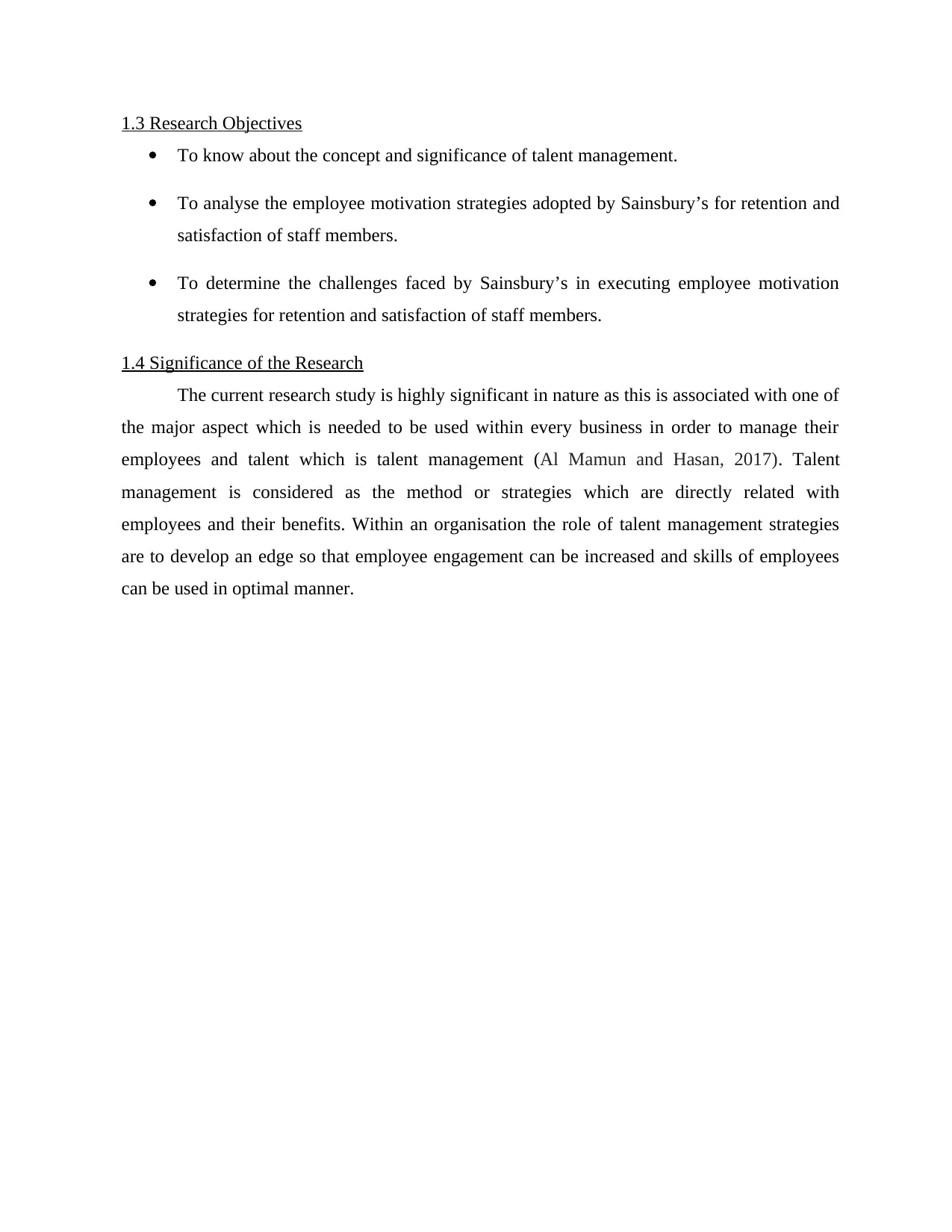
1.3 Research Objectives
To know about the concept and significance of talent management.
To analyse the employee motivation strategies adopted by Sainsbury’s for retention and
satisfaction of staff members.
To determine the challenges faced by Sainsbury’s in executing employee motivation
strategies for retention and satisfaction of staff members.
1.4 Significance of the Research
The current research study is highly significant in nature as this is associated with one of
the major aspect which is needed to be used within every business in order to manage their
employees and talent which is talent management (Al Mamun and Hasan, 2017). Talent
management is considered as the method or strategies which are directly related with
employees and their benefits. Within an organisation the role of talent management strategies
are to develop an edge so that employee engagement can be increased and skills of employees
can be used in optimal manner.
To know about the concept and significance of talent management.
To analyse the employee motivation strategies adopted by Sainsbury’s for retention and
satisfaction of staff members.
To determine the challenges faced by Sainsbury’s in executing employee motivation
strategies for retention and satisfaction of staff members.
1.4 Significance of the Research
The current research study is highly significant in nature as this is associated with one of
the major aspect which is needed to be used within every business in order to manage their
employees and talent which is talent management (Al Mamun and Hasan, 2017). Talent
management is considered as the method or strategies which are directly related with
employees and their benefits. Within an organisation the role of talent management strategies
are to develop an edge so that employee engagement can be increased and skills of employees
can be used in optimal manner.
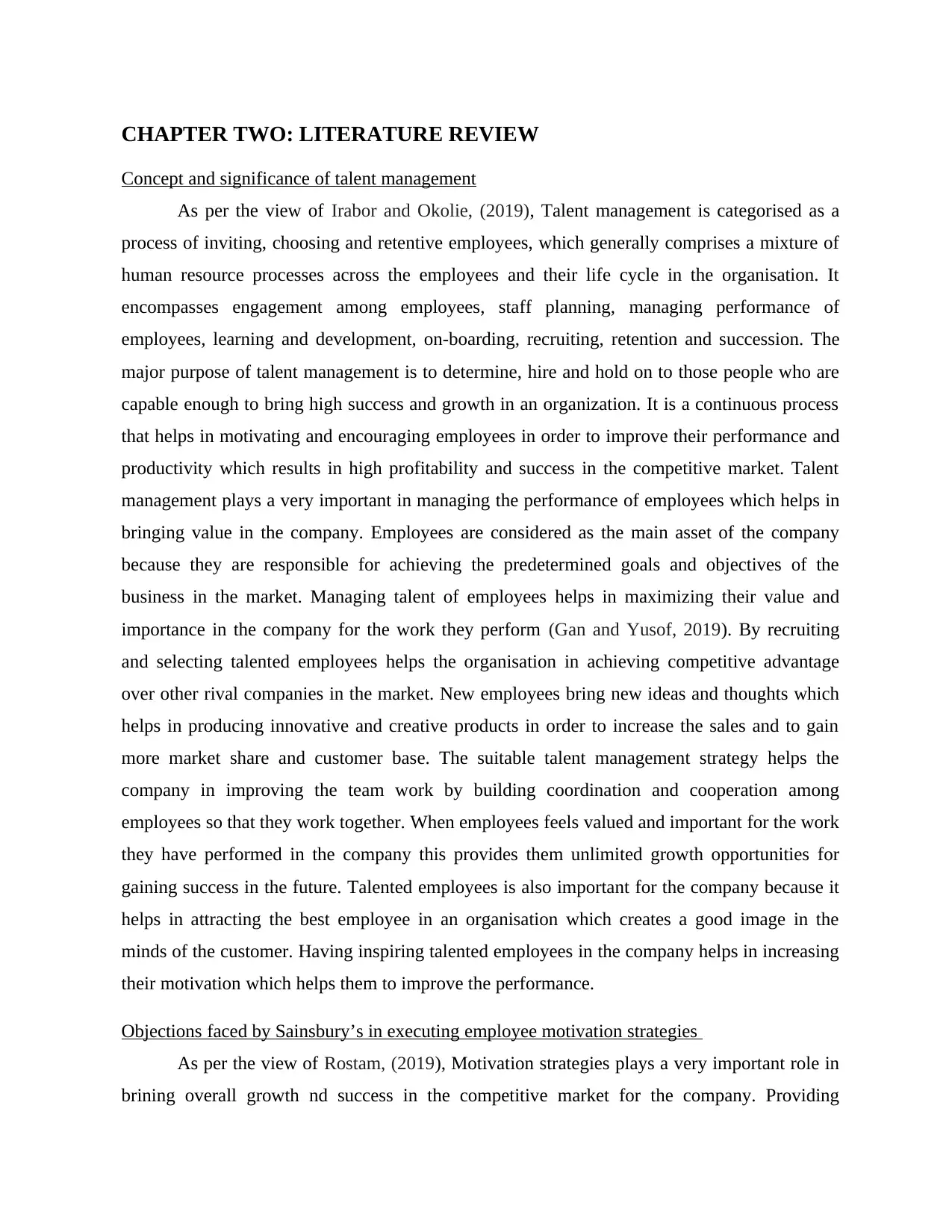
CHAPTER TWO: LITERATURE REVIEW
Concept and significance of talent management
As per the view of Irabor and Okolie, (2019), Talent management is categorised as a
process of inviting, choosing and retentive employees, which generally comprises a mixture of
human resource processes across the employees and their life cycle in the organisation. It
encompasses engagement among employees, staff planning, managing performance of
employees, learning and development, on-boarding, recruiting, retention and succession. The
major purpose of talent management is to determine, hire and hold on to those people who are
capable enough to bring high success and growth in an organization. It is a continuous process
that helps in motivating and encouraging employees in order to improve their performance and
productivity which results in high profitability and success in the competitive market. Talent
management plays a very important in managing the performance of employees which helps in
bringing value in the company. Employees are considered as the main asset of the company
because they are responsible for achieving the predetermined goals and objectives of the
business in the market. Managing talent of employees helps in maximizing their value and
importance in the company for the work they perform (Gan and Yusof, 2019). By recruiting
and selecting talented employees helps the organisation in achieving competitive advantage
over other rival companies in the market. New employees bring new ideas and thoughts which
helps in producing innovative and creative products in order to increase the sales and to gain
more market share and customer base. The suitable talent management strategy helps the
company in improving the team work by building coordination and cooperation among
employees so that they work together. When employees feels valued and important for the work
they have performed in the company this provides them unlimited growth opportunities for
gaining success in the future. Talented employees is also important for the company because it
helps in attracting the best employee in an organisation which creates a good image in the
minds of the customer. Having inspiring talented employees in the company helps in increasing
their motivation which helps them to improve the performance.
Objections faced by Sainsbury’s in executing employee motivation strategies
As per the view of Rostam, (2019), Motivation strategies plays a very important role in
brining overall growth nd success in the competitive market for the company. Providing
Concept and significance of talent management
As per the view of Irabor and Okolie, (2019), Talent management is categorised as a
process of inviting, choosing and retentive employees, which generally comprises a mixture of
human resource processes across the employees and their life cycle in the organisation. It
encompasses engagement among employees, staff planning, managing performance of
employees, learning and development, on-boarding, recruiting, retention and succession. The
major purpose of talent management is to determine, hire and hold on to those people who are
capable enough to bring high success and growth in an organization. It is a continuous process
that helps in motivating and encouraging employees in order to improve their performance and
productivity which results in high profitability and success in the competitive market. Talent
management plays a very important in managing the performance of employees which helps in
bringing value in the company. Employees are considered as the main asset of the company
because they are responsible for achieving the predetermined goals and objectives of the
business in the market. Managing talent of employees helps in maximizing their value and
importance in the company for the work they perform (Gan and Yusof, 2019). By recruiting
and selecting talented employees helps the organisation in achieving competitive advantage
over other rival companies in the market. New employees bring new ideas and thoughts which
helps in producing innovative and creative products in order to increase the sales and to gain
more market share and customer base. The suitable talent management strategy helps the
company in improving the team work by building coordination and cooperation among
employees so that they work together. When employees feels valued and important for the work
they have performed in the company this provides them unlimited growth opportunities for
gaining success in the future. Talented employees is also important for the company because it
helps in attracting the best employee in an organisation which creates a good image in the
minds of the customer. Having inspiring talented employees in the company helps in increasing
their motivation which helps them to improve the performance.
Objections faced by Sainsbury’s in executing employee motivation strategies
As per the view of Rostam, (2019), Motivation strategies plays a very important role in
brining overall growth nd success in the competitive market for the company. Providing
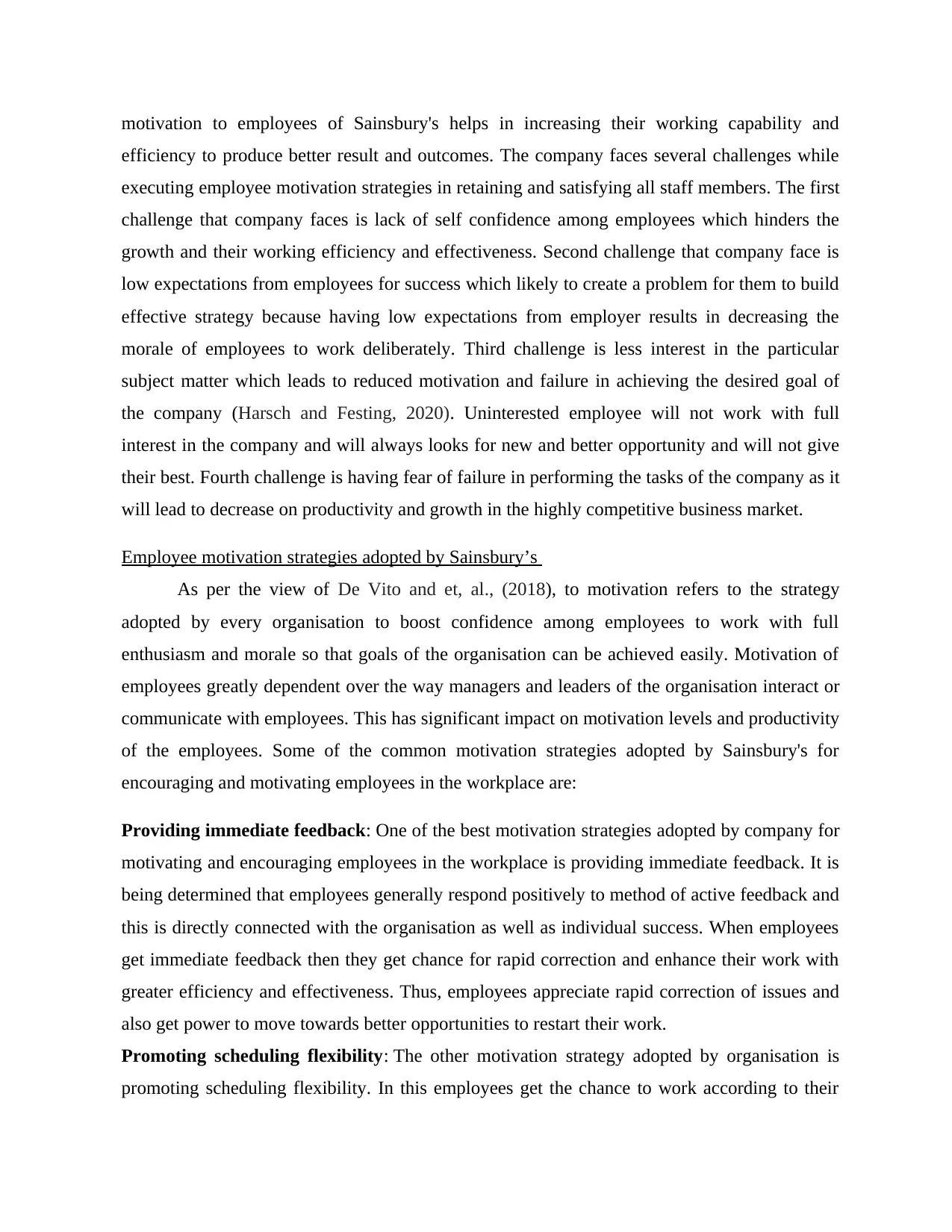
motivation to employees of Sainsbury's helps in increasing their working capability and
efficiency to produce better result and outcomes. The company faces several challenges while
executing employee motivation strategies in retaining and satisfying all staff members. The first
challenge that company faces is lack of self confidence among employees which hinders the
growth and their working efficiency and effectiveness. Second challenge that company face is
low expectations from employees for success which likely to create a problem for them to build
effective strategy because having low expectations from employer results in decreasing the
morale of employees to work deliberately. Third challenge is less interest in the particular
subject matter which leads to reduced motivation and failure in achieving the desired goal of
the company (Harsch and Festing, 2020). Uninterested employee will not work with full
interest in the company and will always looks for new and better opportunity and will not give
their best. Fourth challenge is having fear of failure in performing the tasks of the company as it
will lead to decrease on productivity and growth in the highly competitive business market.
Employee motivation strategies adopted by Sainsbury’s
As per the view of De Vito and et, al., (2018), to motivation refers to the strategy
adopted by every organisation to boost confidence among employees to work with full
enthusiasm and morale so that goals of the organisation can be achieved easily. Motivation of
employees greatly dependent over the way managers and leaders of the organisation interact or
communicate with employees. This has significant impact on motivation levels and productivity
of the employees. Some of the common motivation strategies adopted by Sainsbury's for
encouraging and motivating employees in the workplace are:
Providing immediate feedback: One of the best motivation strategies adopted by company for
motivating and encouraging employees in the workplace is providing immediate feedback. It is
being determined that employees generally respond positively to method of active feedback and
this is directly connected with the organisation as well as individual success. When employees
get immediate feedback then they get chance for rapid correction and enhance their work with
greater efficiency and effectiveness. Thus, employees appreciate rapid correction of issues and
also get power to move towards better opportunities to restart their work.
Promoting scheduling flexibility: The other motivation strategy adopted by organisation is
promoting scheduling flexibility. In this employees get the chance to work according to their
efficiency to produce better result and outcomes. The company faces several challenges while
executing employee motivation strategies in retaining and satisfying all staff members. The first
challenge that company faces is lack of self confidence among employees which hinders the
growth and their working efficiency and effectiveness. Second challenge that company face is
low expectations from employees for success which likely to create a problem for them to build
effective strategy because having low expectations from employer results in decreasing the
morale of employees to work deliberately. Third challenge is less interest in the particular
subject matter which leads to reduced motivation and failure in achieving the desired goal of
the company (Harsch and Festing, 2020). Uninterested employee will not work with full
interest in the company and will always looks for new and better opportunity and will not give
their best. Fourth challenge is having fear of failure in performing the tasks of the company as it
will lead to decrease on productivity and growth in the highly competitive business market.
Employee motivation strategies adopted by Sainsbury’s
As per the view of De Vito and et, al., (2018), to motivation refers to the strategy
adopted by every organisation to boost confidence among employees to work with full
enthusiasm and morale so that goals of the organisation can be achieved easily. Motivation of
employees greatly dependent over the way managers and leaders of the organisation interact or
communicate with employees. This has significant impact on motivation levels and productivity
of the employees. Some of the common motivation strategies adopted by Sainsbury's for
encouraging and motivating employees in the workplace are:
Providing immediate feedback: One of the best motivation strategies adopted by company for
motivating and encouraging employees in the workplace is providing immediate feedback. It is
being determined that employees generally respond positively to method of active feedback and
this is directly connected with the organisation as well as individual success. When employees
get immediate feedback then they get chance for rapid correction and enhance their work with
greater efficiency and effectiveness. Thus, employees appreciate rapid correction of issues and
also get power to move towards better opportunities to restart their work.
Promoting scheduling flexibility: The other motivation strategy adopted by organisation is
promoting scheduling flexibility. In this employees get the chance to work according to their
Paraphrase This Document
Need a fresh take? Get an instant paraphrase of this document with our AI Paraphraser
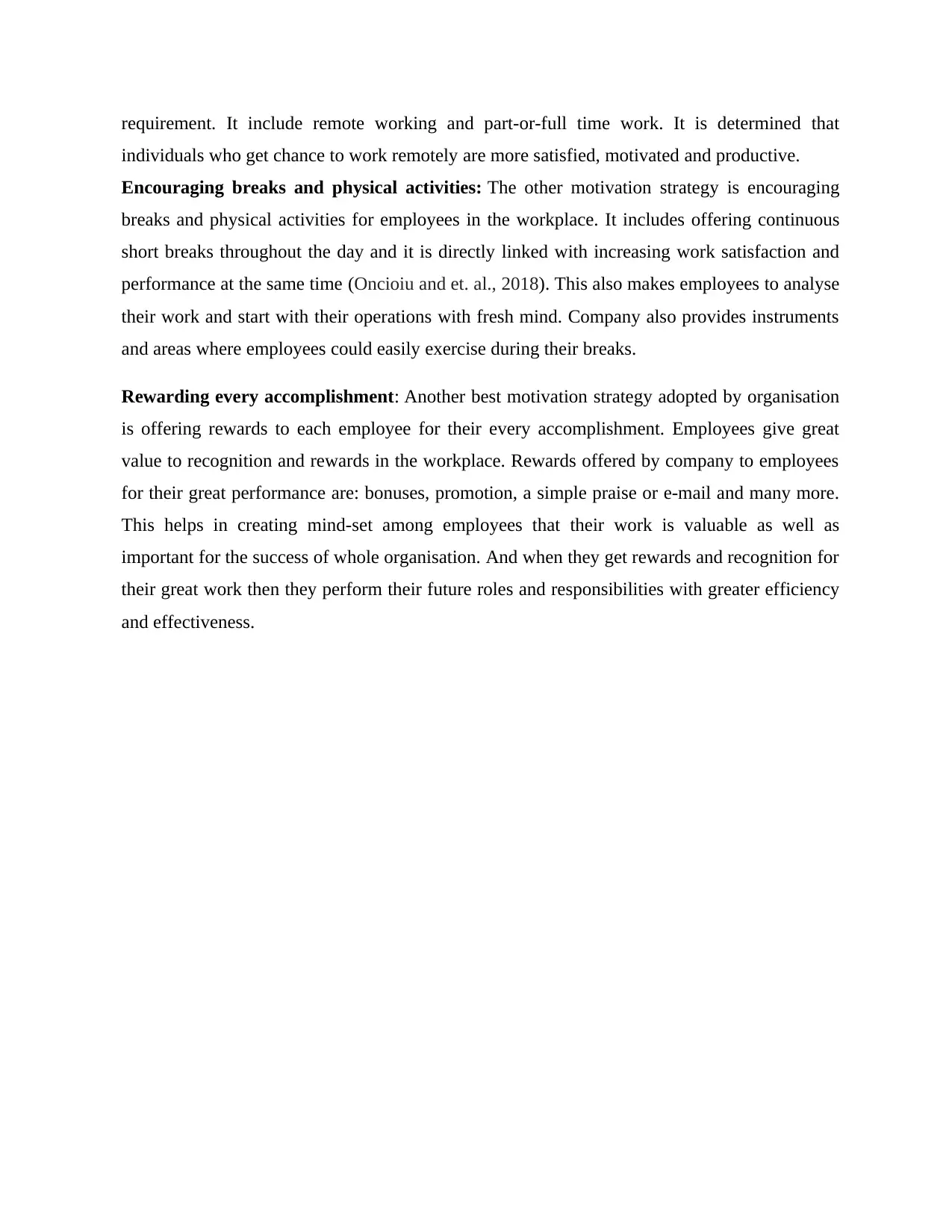
requirement. It include remote working and part-or-full time work. It is determined that
individuals who get chance to work remotely are more satisfied, motivated and productive.
Encouraging breaks and physical activities: The other motivation strategy is encouraging
breaks and physical activities for employees in the workplace. It includes offering continuous
short breaks throughout the day and it is directly linked with increasing work satisfaction and
performance at the same time (Oncioiu and et. al., 2018). This also makes employees to analyse
their work and start with their operations with fresh mind. Company also provides instruments
and areas where employees could easily exercise during their breaks.
Rewarding every accomplishment: Another best motivation strategy adopted by organisation
is offering rewards to each employee for their every accomplishment. Employees give great
value to recognition and rewards in the workplace. Rewards offered by company to employees
for their great performance are: bonuses, promotion, a simple praise or e-mail and many more.
This helps in creating mind-set among employees that their work is valuable as well as
important for the success of whole organisation. And when they get rewards and recognition for
their great work then they perform their future roles and responsibilities with greater efficiency
and effectiveness.
individuals who get chance to work remotely are more satisfied, motivated and productive.
Encouraging breaks and physical activities: The other motivation strategy is encouraging
breaks and physical activities for employees in the workplace. It includes offering continuous
short breaks throughout the day and it is directly linked with increasing work satisfaction and
performance at the same time (Oncioiu and et. al., 2018). This also makes employees to analyse
their work and start with their operations with fresh mind. Company also provides instruments
and areas where employees could easily exercise during their breaks.
Rewarding every accomplishment: Another best motivation strategy adopted by organisation
is offering rewards to each employee for their every accomplishment. Employees give great
value to recognition and rewards in the workplace. Rewards offered by company to employees
for their great performance are: bonuses, promotion, a simple praise or e-mail and many more.
This helps in creating mind-set among employees that their work is valuable as well as
important for the success of whole organisation. And when they get rewards and recognition for
their great work then they perform their future roles and responsibilities with greater efficiency
and effectiveness.
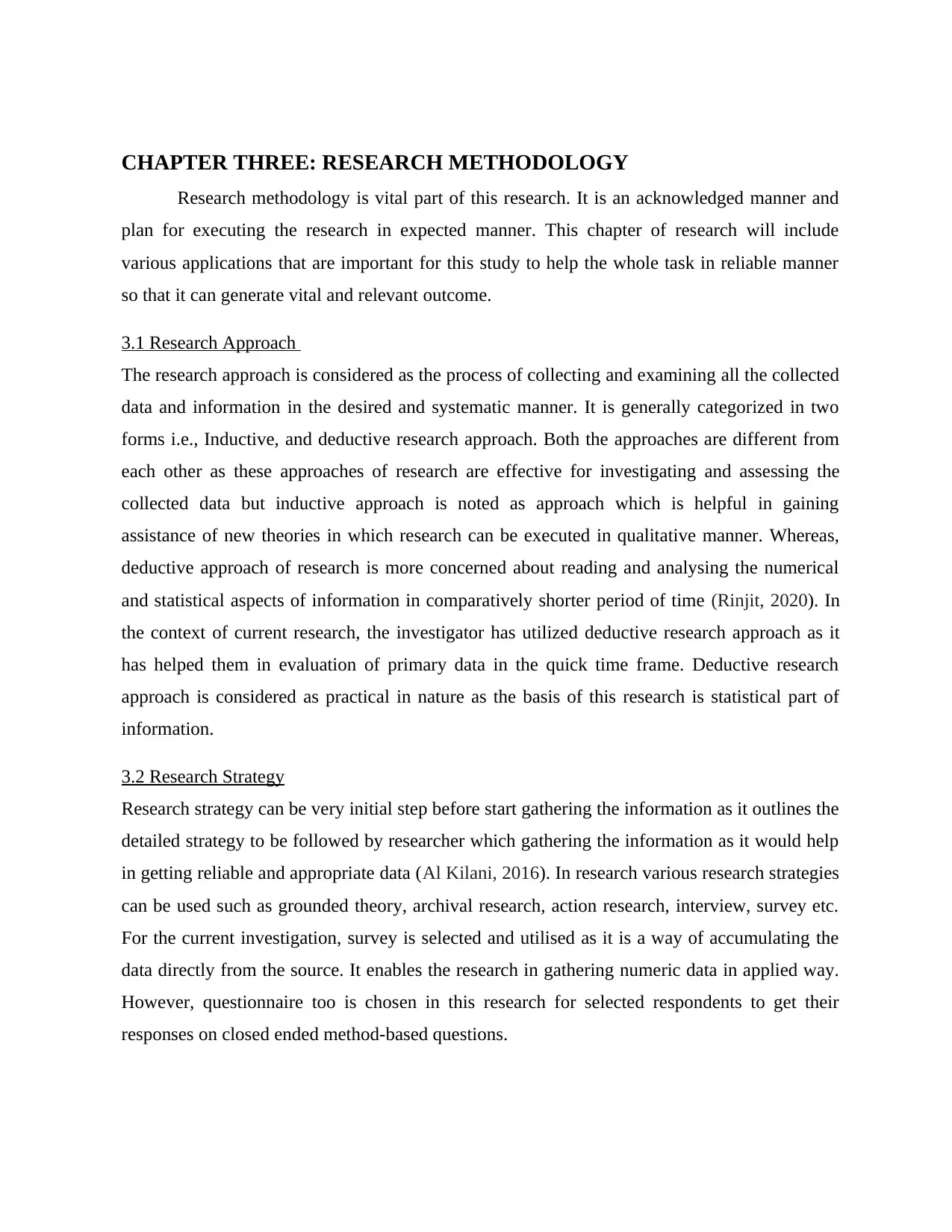
CHAPTER THREE: RESEARCH METHODOLOGY
Research methodology is vital part of this research. It is an acknowledged manner and
plan for executing the research in expected manner. This chapter of research will include
various applications that are important for this study to help the whole task in reliable manner
so that it can generate vital and relevant outcome.
3.1 Research Approach
The research approach is considered as the process of collecting and examining all the collected
data and information in the desired and systematic manner. It is generally categorized in two
forms i.e., Inductive, and deductive research approach. Both the approaches are different from
each other as these approaches of research are effective for investigating and assessing the
collected data but inductive approach is noted as approach which is helpful in gaining
assistance of new theories in which research can be executed in qualitative manner. Whereas,
deductive approach of research is more concerned about reading and analysing the numerical
and statistical aspects of information in comparatively shorter period of time (Rinjit, 2020). In
the context of current research, the investigator has utilized deductive research approach as it
has helped them in evaluation of primary data in the quick time frame. Deductive research
approach is considered as practical in nature as the basis of this research is statistical part of
information.
3.2 Research Strategy
Research strategy can be very initial step before start gathering the information as it outlines the
detailed strategy to be followed by researcher which gathering the information as it would help
in getting reliable and appropriate data (Al Kilani, 2016). In research various research strategies
can be used such as grounded theory, archival research, action research, interview, survey etc.
For the current investigation, survey is selected and utilised as it is a way of accumulating the
data directly from the source. It enables the research in gathering numeric data in applied way.
However, questionnaire too is chosen in this research for selected respondents to get their
responses on closed ended method-based questions.
Research methodology is vital part of this research. It is an acknowledged manner and
plan for executing the research in expected manner. This chapter of research will include
various applications that are important for this study to help the whole task in reliable manner
so that it can generate vital and relevant outcome.
3.1 Research Approach
The research approach is considered as the process of collecting and examining all the collected
data and information in the desired and systematic manner. It is generally categorized in two
forms i.e., Inductive, and deductive research approach. Both the approaches are different from
each other as these approaches of research are effective for investigating and assessing the
collected data but inductive approach is noted as approach which is helpful in gaining
assistance of new theories in which research can be executed in qualitative manner. Whereas,
deductive approach of research is more concerned about reading and analysing the numerical
and statistical aspects of information in comparatively shorter period of time (Rinjit, 2020). In
the context of current research, the investigator has utilized deductive research approach as it
has helped them in evaluation of primary data in the quick time frame. Deductive research
approach is considered as practical in nature as the basis of this research is statistical part of
information.
3.2 Research Strategy
Research strategy can be very initial step before start gathering the information as it outlines the
detailed strategy to be followed by researcher which gathering the information as it would help
in getting reliable and appropriate data (Al Kilani, 2016). In research various research strategies
can be used such as grounded theory, archival research, action research, interview, survey etc.
For the current investigation, survey is selected and utilised as it is a way of accumulating the
data directly from the source. It enables the research in gathering numeric data in applied way.
However, questionnaire too is chosen in this research for selected respondents to get their
responses on closed ended method-based questions.
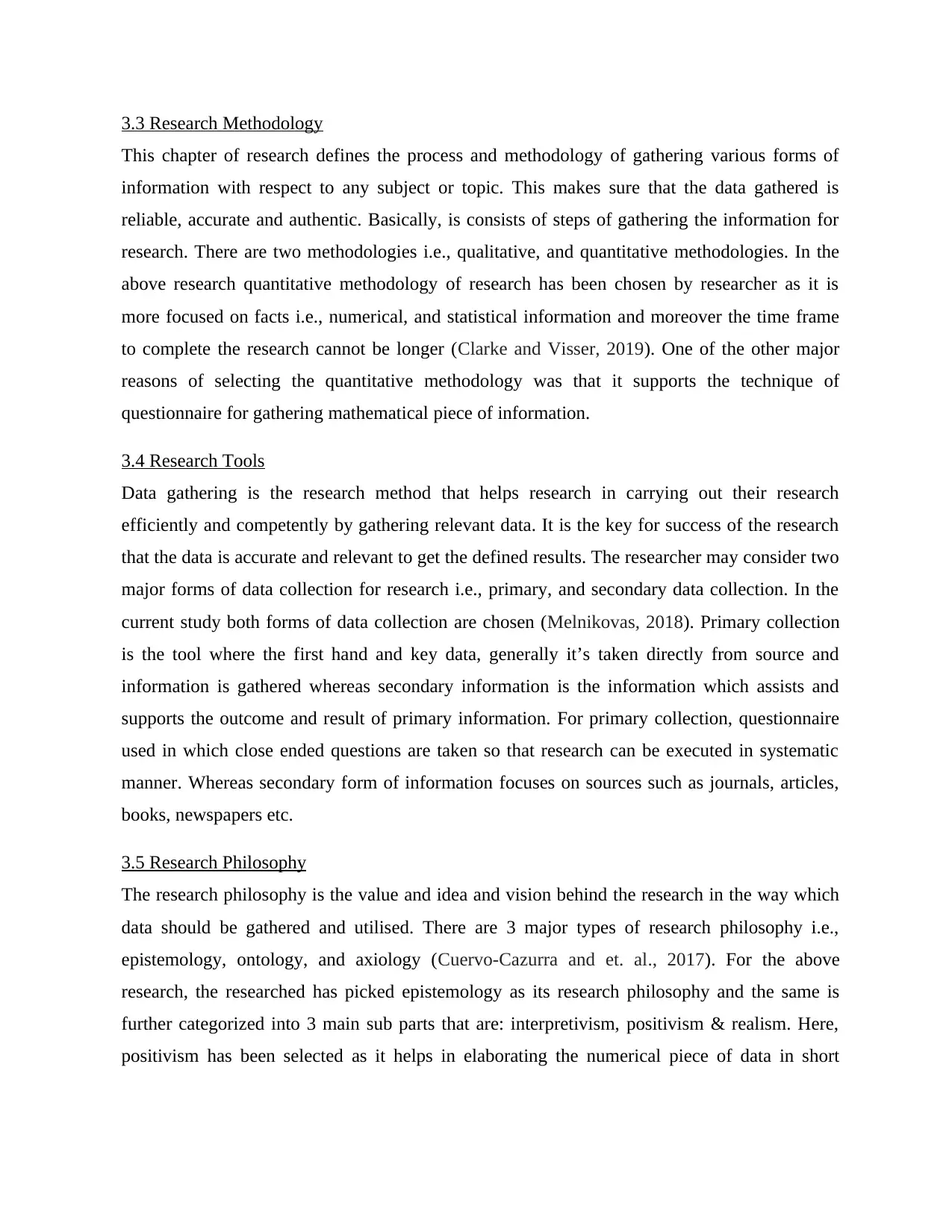
3.3 Research Methodology
This chapter of research defines the process and methodology of gathering various forms of
information with respect to any subject or topic. This makes sure that the data gathered is
reliable, accurate and authentic. Basically, is consists of steps of gathering the information for
research. There are two methodologies i.e., qualitative, and quantitative methodologies. In the
above research quantitative methodology of research has been chosen by researcher as it is
more focused on facts i.e., numerical, and statistical information and moreover the time frame
to complete the research cannot be longer (Clarke and Visser, 2019). One of the other major
reasons of selecting the quantitative methodology was that it supports the technique of
questionnaire for gathering mathematical piece of information.
3.4 Research Tools
Data gathering is the research method that helps research in carrying out their research
efficiently and competently by gathering relevant data. It is the key for success of the research
that the data is accurate and relevant to get the defined results. The researcher may consider two
major forms of data collection for research i.e., primary, and secondary data collection. In the
current study both forms of data collection are chosen (Melnikovas, 2018). Primary collection
is the tool where the first hand and key data, generally it’s taken directly from source and
information is gathered whereas secondary information is the information which assists and
supports the outcome and result of primary information. For primary collection, questionnaire
used in which close ended questions are taken so that research can be executed in systematic
manner. Whereas secondary form of information focuses on sources such as journals, articles,
books, newspapers etc.
3.5 Research Philosophy
The research philosophy is the value and idea and vision behind the research in the way which
data should be gathered and utilised. There are 3 major types of research philosophy i.e.,
epistemology, ontology, and axiology (Cuervo‐Cazurra and et. al., 2017). For the above
research, the researched has picked epistemology as its research philosophy and the same is
further categorized into 3 main sub parts that are: interpretivism, positivism & realism. Here,
positivism has been selected as it helps in elaborating the numerical piece of data in short
This chapter of research defines the process and methodology of gathering various forms of
information with respect to any subject or topic. This makes sure that the data gathered is
reliable, accurate and authentic. Basically, is consists of steps of gathering the information for
research. There are two methodologies i.e., qualitative, and quantitative methodologies. In the
above research quantitative methodology of research has been chosen by researcher as it is
more focused on facts i.e., numerical, and statistical information and moreover the time frame
to complete the research cannot be longer (Clarke and Visser, 2019). One of the other major
reasons of selecting the quantitative methodology was that it supports the technique of
questionnaire for gathering mathematical piece of information.
3.4 Research Tools
Data gathering is the research method that helps research in carrying out their research
efficiently and competently by gathering relevant data. It is the key for success of the research
that the data is accurate and relevant to get the defined results. The researcher may consider two
major forms of data collection for research i.e., primary, and secondary data collection. In the
current study both forms of data collection are chosen (Melnikovas, 2018). Primary collection
is the tool where the first hand and key data, generally it’s taken directly from source and
information is gathered whereas secondary information is the information which assists and
supports the outcome and result of primary information. For primary collection, questionnaire
used in which close ended questions are taken so that research can be executed in systematic
manner. Whereas secondary form of information focuses on sources such as journals, articles,
books, newspapers etc.
3.5 Research Philosophy
The research philosophy is the value and idea and vision behind the research in the way which
data should be gathered and utilised. There are 3 major types of research philosophy i.e.,
epistemology, ontology, and axiology (Cuervo‐Cazurra and et. al., 2017). For the above
research, the researched has picked epistemology as its research philosophy and the same is
further categorized into 3 main sub parts that are: interpretivism, positivism & realism. Here,
positivism has been selected as it helps in elaborating the numerical piece of data in short
Secure Best Marks with AI Grader
Need help grading? Try our AI Grader for instant feedback on your assignments.
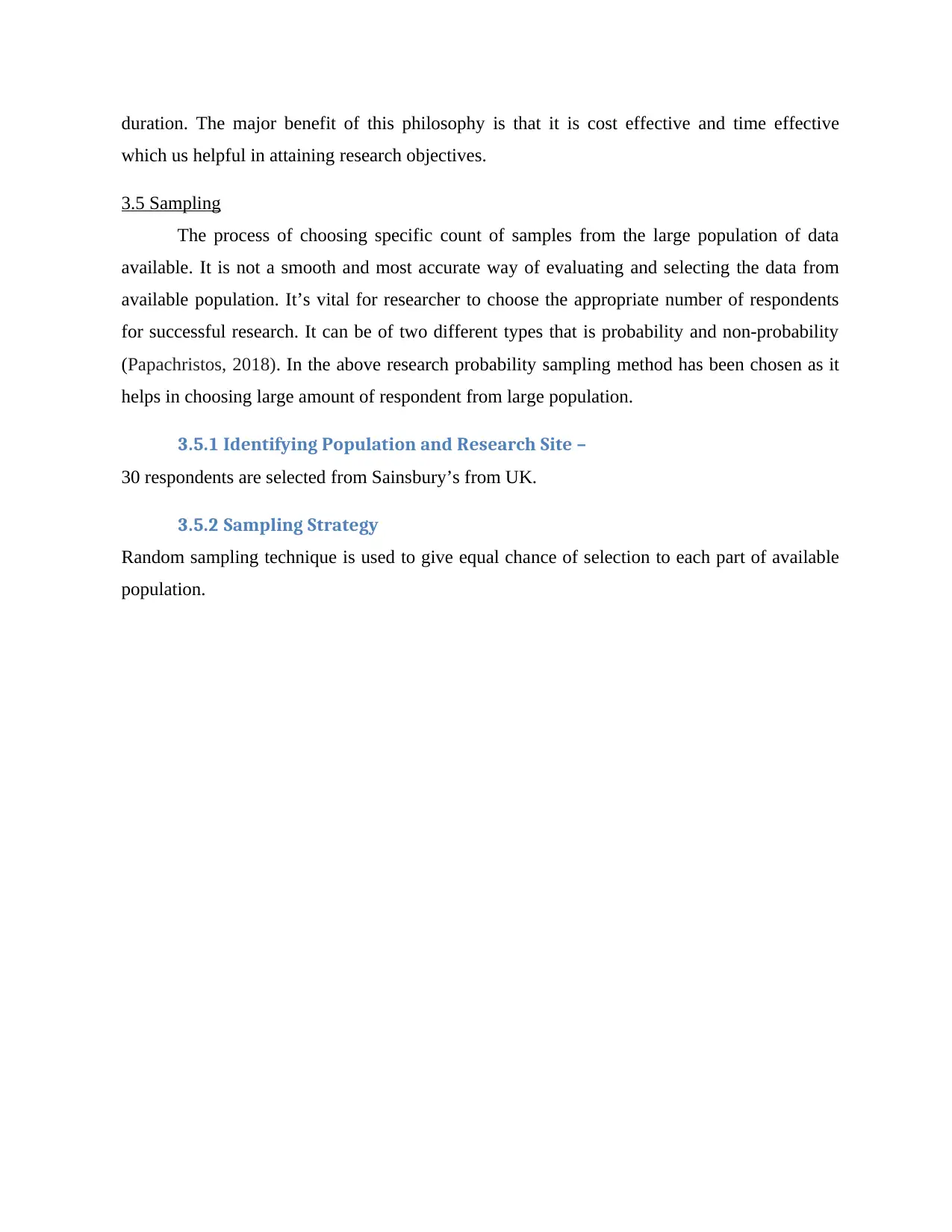
duration. The major benefit of this philosophy is that it is cost effective and time effective
which us helpful in attaining research objectives.
3.5 Sampling
The process of choosing specific count of samples from the large population of data
available. It is not a smooth and most accurate way of evaluating and selecting the data from
available population. It’s vital for researcher to choose the appropriate number of respondents
for successful research. It can be of two different types that is probability and non-probability
(Papachristos, 2018). In the above research probability sampling method has been chosen as it
helps in choosing large amount of respondent from large population.
3.5.1 Identifying Population and Research Site –
30 respondents are selected from Sainsbury’s from UK.
3.5.2 Sampling Strategy
Random sampling technique is used to give equal chance of selection to each part of available
population.
which us helpful in attaining research objectives.
3.5 Sampling
The process of choosing specific count of samples from the large population of data
available. It is not a smooth and most accurate way of evaluating and selecting the data from
available population. It’s vital for researcher to choose the appropriate number of respondents
for successful research. It can be of two different types that is probability and non-probability
(Papachristos, 2018). In the above research probability sampling method has been chosen as it
helps in choosing large amount of respondent from large population.
3.5.1 Identifying Population and Research Site –
30 respondents are selected from Sainsbury’s from UK.
3.5.2 Sampling Strategy
Random sampling technique is used to give equal chance of selection to each part of available
population.
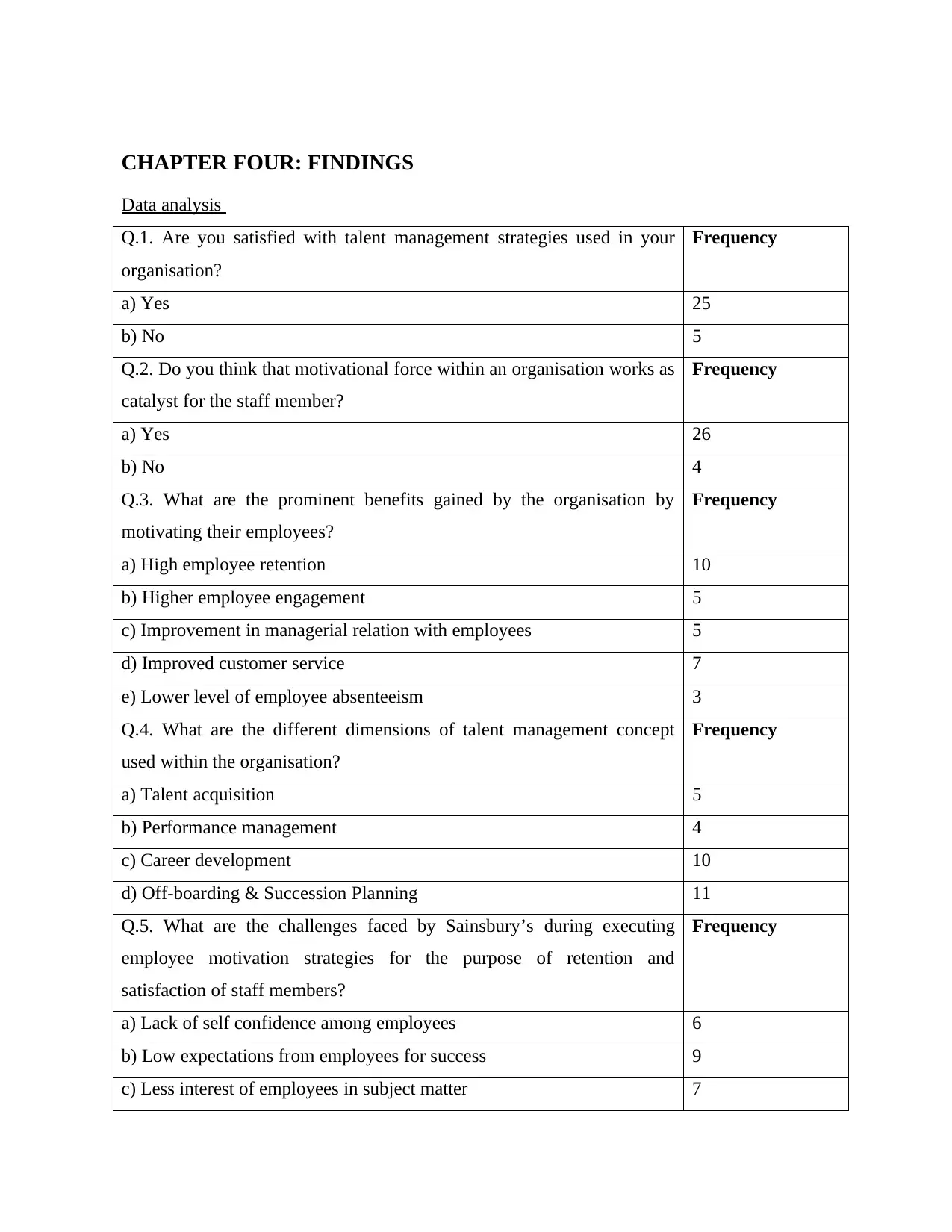
CHAPTER FOUR: FINDINGS
Data analysis
Q.1. Are you satisfied with talent management strategies used in your
organisation?
Frequency
a) Yes 25
b) No 5
Q.2. Do you think that motivational force within an organisation works as
catalyst for the staff member?
Frequency
a) Yes 26
b) No 4
Q.3. What are the prominent benefits gained by the organisation by
motivating their employees?
Frequency
a) High employee retention 10
b) Higher employee engagement 5
c) Improvement in managerial relation with employees 5
d) Improved customer service 7
e) Lower level of employee absenteeism 3
Q.4. What are the different dimensions of talent management concept
used within the organisation?
Frequency
a) Talent acquisition 5
b) Performance management 4
c) Career development 10
d) Off-boarding & Succession Planning 11
Q.5. What are the challenges faced by Sainsbury’s during executing
employee motivation strategies for the purpose of retention and
satisfaction of staff members?
Frequency
a) Lack of self confidence among employees 6
b) Low expectations from employees for success 9
c) Less interest of employees in subject matter 7
Data analysis
Q.1. Are you satisfied with talent management strategies used in your
organisation?
Frequency
a) Yes 25
b) No 5
Q.2. Do you think that motivational force within an organisation works as
catalyst for the staff member?
Frequency
a) Yes 26
b) No 4
Q.3. What are the prominent benefits gained by the organisation by
motivating their employees?
Frequency
a) High employee retention 10
b) Higher employee engagement 5
c) Improvement in managerial relation with employees 5
d) Improved customer service 7
e) Lower level of employee absenteeism 3
Q.4. What are the different dimensions of talent management concept
used within the organisation?
Frequency
a) Talent acquisition 5
b) Performance management 4
c) Career development 10
d) Off-boarding & Succession Planning 11
Q.5. What are the challenges faced by Sainsbury’s during executing
employee motivation strategies for the purpose of retention and
satisfaction of staff members?
Frequency
a) Lack of self confidence among employees 6
b) Low expectations from employees for success 9
c) Less interest of employees in subject matter 7
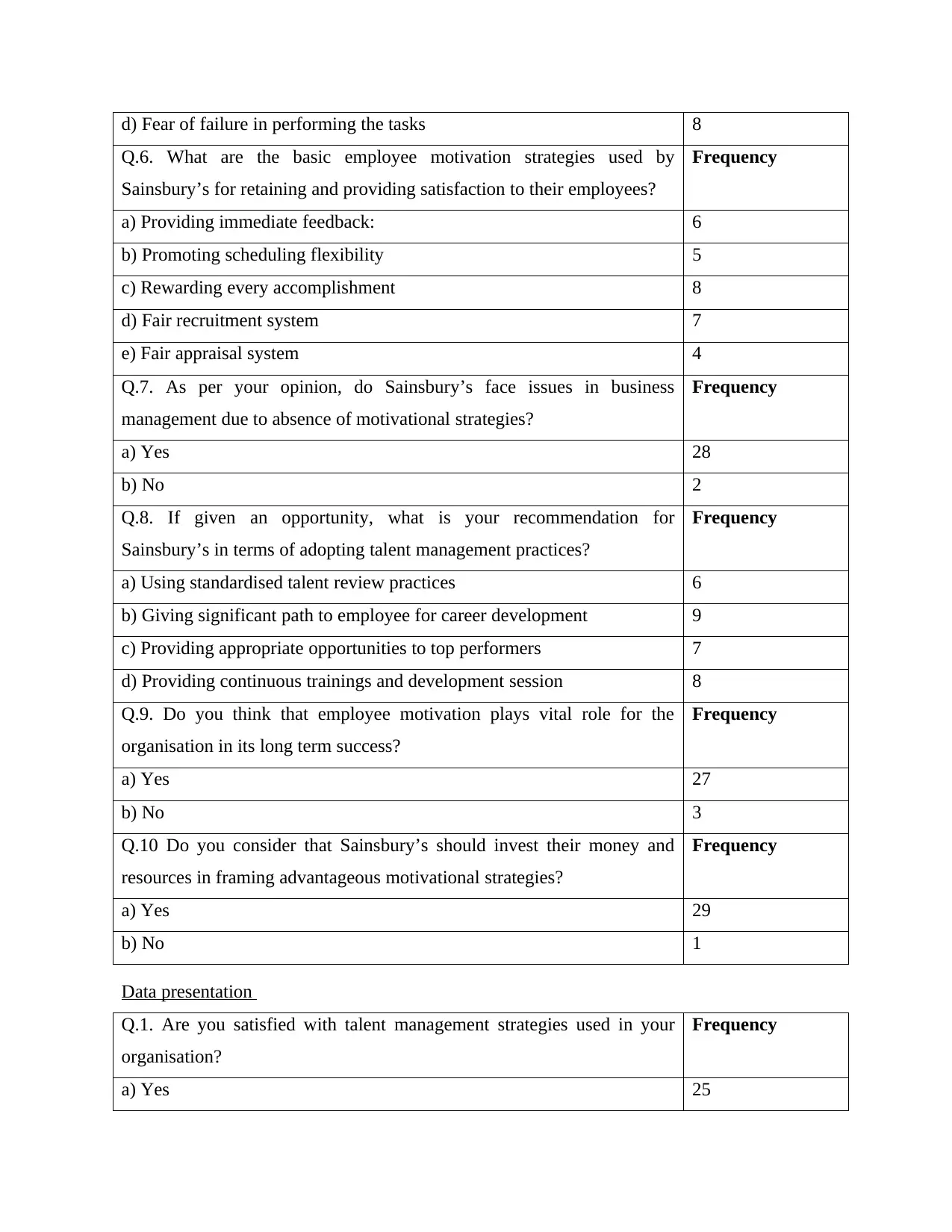
d) Fear of failure in performing the tasks 8
Q.6. What are the basic employee motivation strategies used by
Sainsbury’s for retaining and providing satisfaction to their employees?
Frequency
a) Providing immediate feedback: 6
b) Promoting scheduling flexibility 5
c) Rewarding every accomplishment 8
d) Fair recruitment system 7
e) Fair appraisal system 4
Q.7. As per your opinion, do Sainsbury’s face issues in business
management due to absence of motivational strategies?
Frequency
a) Yes 28
b) No 2
Q.8. If given an opportunity, what is your recommendation for
Sainsbury’s in terms of adopting talent management practices?
Frequency
a) Using standardised talent review practices 6
b) Giving significant path to employee for career development 9
c) Providing appropriate opportunities to top performers 7
d) Providing continuous trainings and development session 8
Q.9. Do you think that employee motivation plays vital role for the
organisation in its long term success?
Frequency
a) Yes 27
b) No 3
Q.10 Do you consider that Sainsbury’s should invest their money and
resources in framing advantageous motivational strategies?
Frequency
a) Yes 29
b) No 1
Data presentation
Q.1. Are you satisfied with talent management strategies used in your
organisation?
Frequency
a) Yes 25
Q.6. What are the basic employee motivation strategies used by
Sainsbury’s for retaining and providing satisfaction to their employees?
Frequency
a) Providing immediate feedback: 6
b) Promoting scheduling flexibility 5
c) Rewarding every accomplishment 8
d) Fair recruitment system 7
e) Fair appraisal system 4
Q.7. As per your opinion, do Sainsbury’s face issues in business
management due to absence of motivational strategies?
Frequency
a) Yes 28
b) No 2
Q.8. If given an opportunity, what is your recommendation for
Sainsbury’s in terms of adopting talent management practices?
Frequency
a) Using standardised talent review practices 6
b) Giving significant path to employee for career development 9
c) Providing appropriate opportunities to top performers 7
d) Providing continuous trainings and development session 8
Q.9. Do you think that employee motivation plays vital role for the
organisation in its long term success?
Frequency
a) Yes 27
b) No 3
Q.10 Do you consider that Sainsbury’s should invest their money and
resources in framing advantageous motivational strategies?
Frequency
a) Yes 29
b) No 1
Data presentation
Q.1. Are you satisfied with talent management strategies used in your
organisation?
Frequency
a) Yes 25
Paraphrase This Document
Need a fresh take? Get an instant paraphrase of this document with our AI Paraphraser
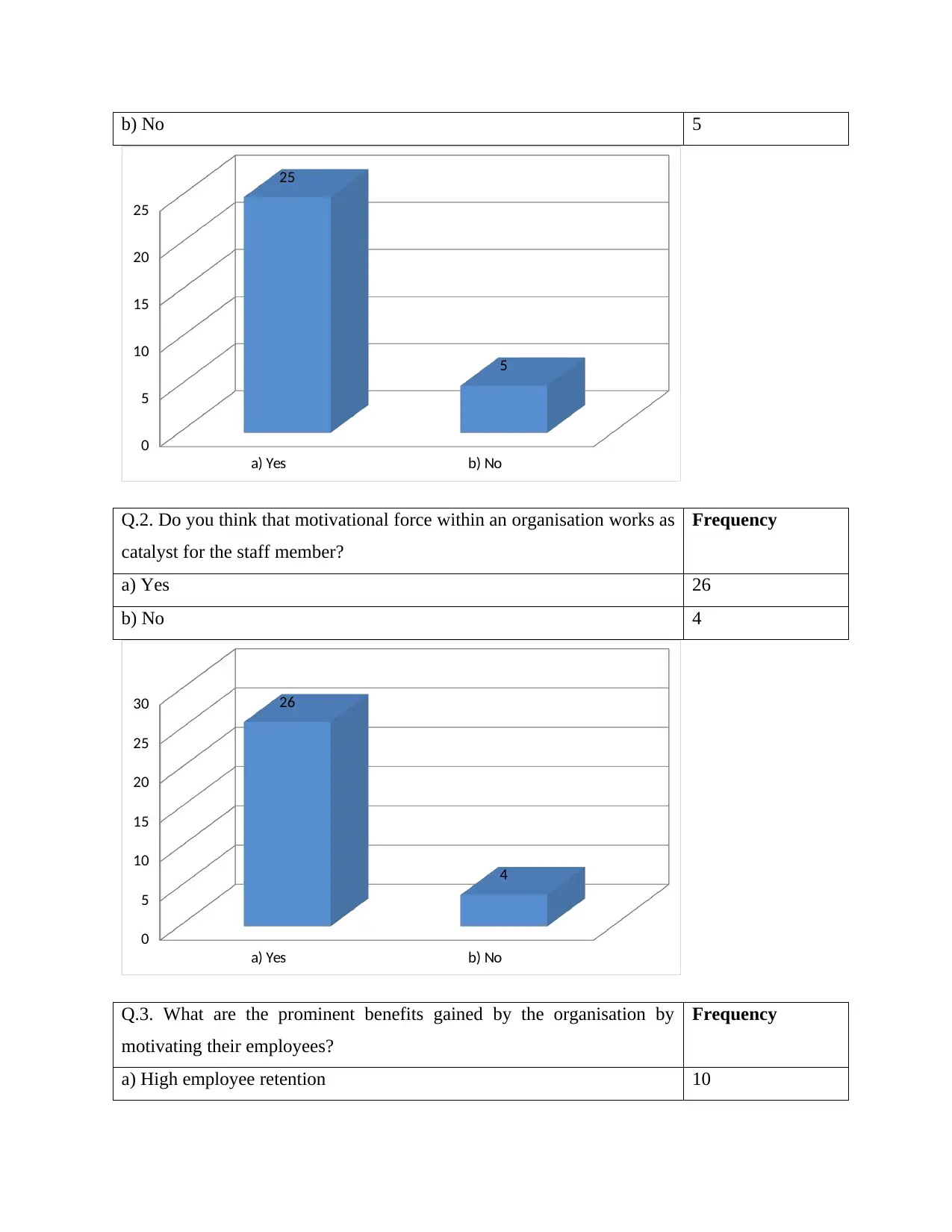
b) No 5
a) Yes b) No
0
5
10
15
20
25
25
5
Q.2. Do you think that motivational force within an organisation works as
catalyst for the staff member?
Frequency
a) Yes 26
b) No 4
a) Yes b) No
0
5
10
15
20
25
30 26
4
Q.3. What are the prominent benefits gained by the organisation by
motivating their employees?
Frequency
a) High employee retention 10
a) Yes b) No
0
5
10
15
20
25
25
5
Q.2. Do you think that motivational force within an organisation works as
catalyst for the staff member?
Frequency
a) Yes 26
b) No 4
a) Yes b) No
0
5
10
15
20
25
30 26
4
Q.3. What are the prominent benefits gained by the organisation by
motivating their employees?
Frequency
a) High employee retention 10
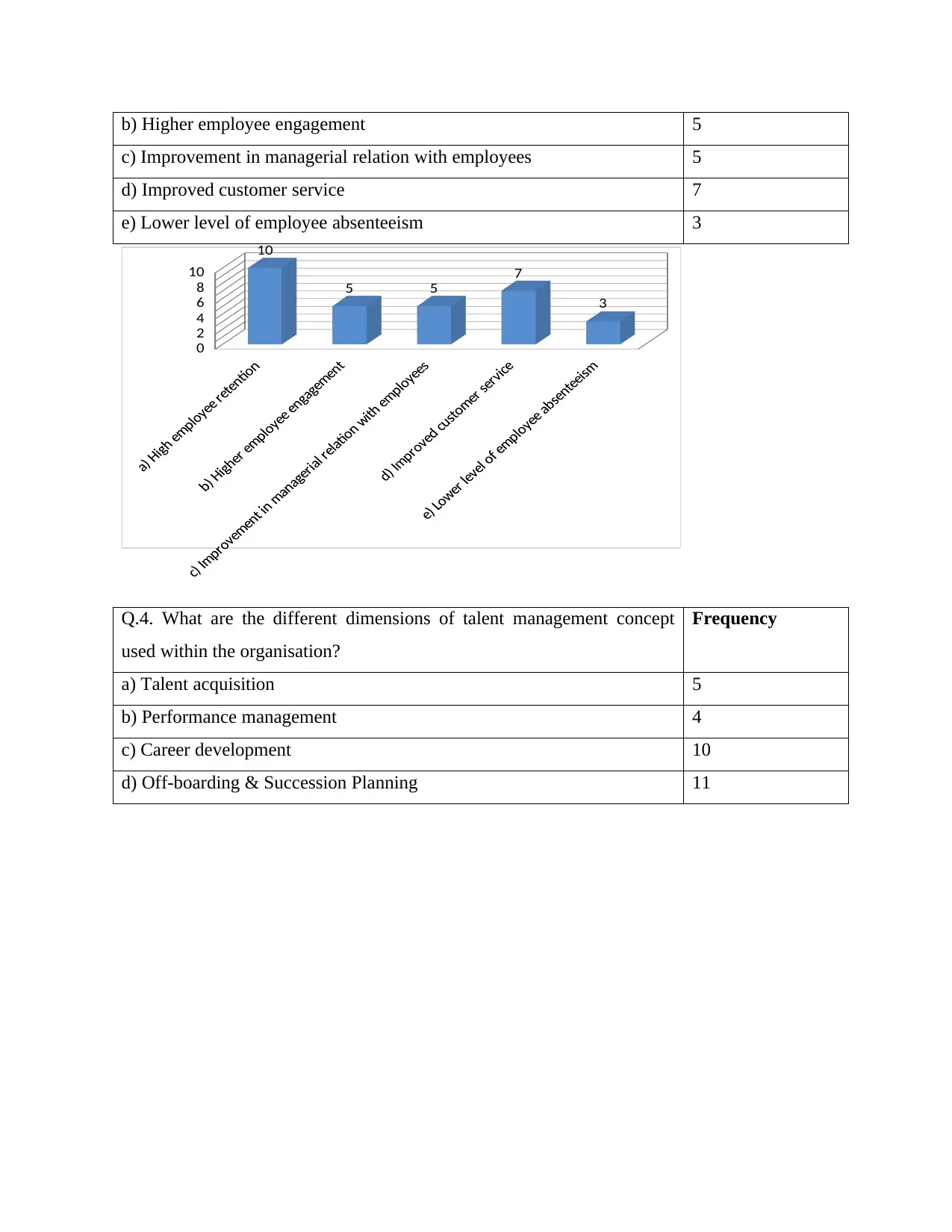
b) Higher employee engagement 5
c) Improvement in managerial relation with employees 5
d) Improved customer service 7
e) Lower level of employee absenteeism 3
0
2
4
6
8
10
10
5 5
7
3
Q.4. What are the different dimensions of talent management concept
used within the organisation?
Frequency
a) Talent acquisition 5
b) Performance management 4
c) Career development 10
d) Off-boarding & Succession Planning 11
c) Improvement in managerial relation with employees 5
d) Improved customer service 7
e) Lower level of employee absenteeism 3
0
2
4
6
8
10
10
5 5
7
3
Q.4. What are the different dimensions of talent management concept
used within the organisation?
Frequency
a) Talent acquisition 5
b) Performance management 4
c) Career development 10
d) Off-boarding & Succession Planning 11
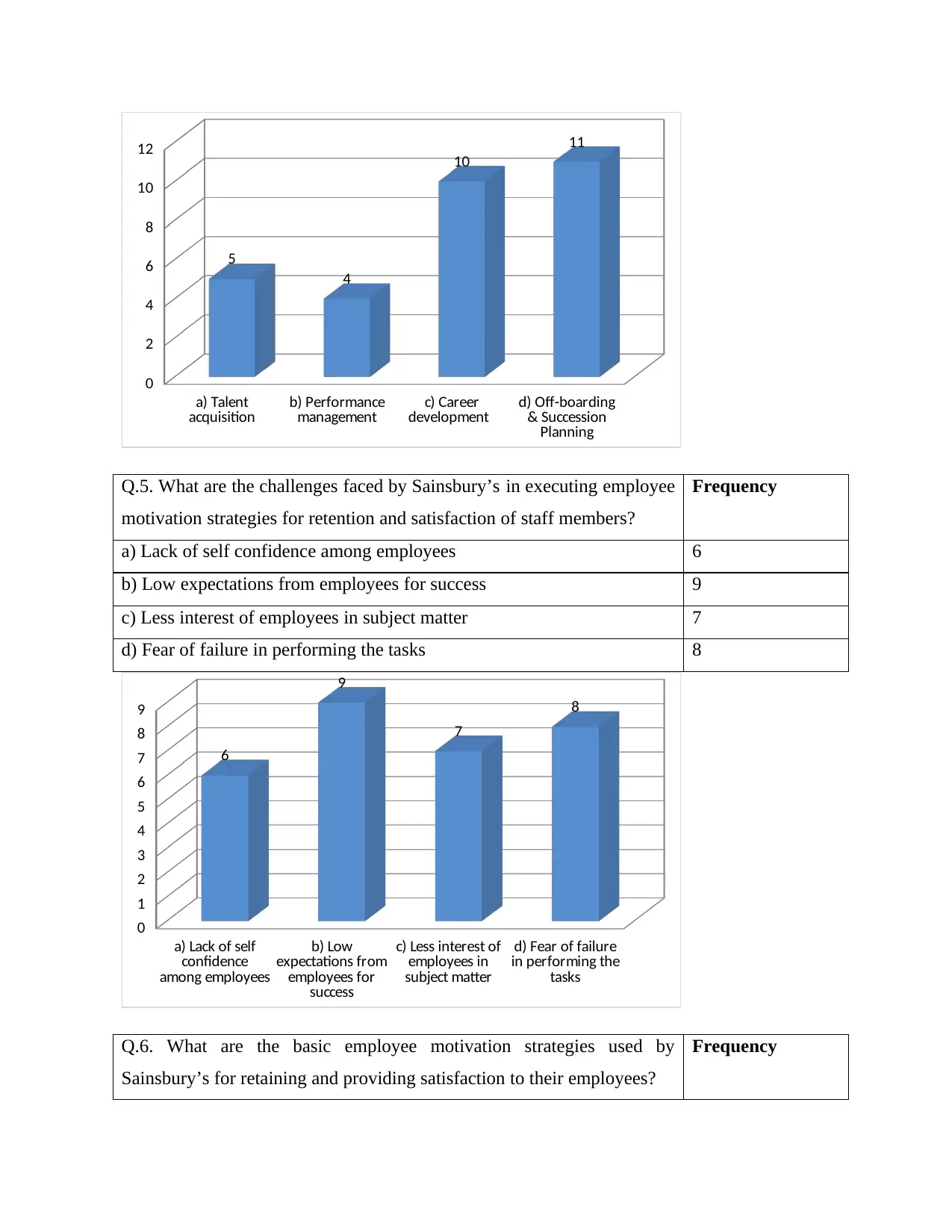
a) Talent
acquisition b) Performance
management c) Career
development d) Off-boarding
& Succession
Planning
0
2
4
6
8
10
12
5
4
10
11
Q.5. What are the challenges faced by Sainsbury’s in executing employee
motivation strategies for retention and satisfaction of staff members?
Frequency
a) Lack of self confidence among employees 6
b) Low expectations from employees for success 9
c) Less interest of employees in subject matter 7
d) Fear of failure in performing the tasks 8
a) Lack of self
confidence
among employees
b) Low
expectations from
employees for
success
c) Less interest of
employees in
subject matter
d) Fear of failure
in performing the
tasks
0
1
2
3
4
5
6
7
8
9
6
9
7
8
Q.6. What are the basic employee motivation strategies used by
Sainsbury’s for retaining and providing satisfaction to their employees?
Frequency
acquisition b) Performance
management c) Career
development d) Off-boarding
& Succession
Planning
0
2
4
6
8
10
12
5
4
10
11
Q.5. What are the challenges faced by Sainsbury’s in executing employee
motivation strategies for retention and satisfaction of staff members?
Frequency
a) Lack of self confidence among employees 6
b) Low expectations from employees for success 9
c) Less interest of employees in subject matter 7
d) Fear of failure in performing the tasks 8
a) Lack of self
confidence
among employees
b) Low
expectations from
employees for
success
c) Less interest of
employees in
subject matter
d) Fear of failure
in performing the
tasks
0
1
2
3
4
5
6
7
8
9
6
9
7
8
Q.6. What are the basic employee motivation strategies used by
Sainsbury’s for retaining and providing satisfaction to their employees?
Frequency
Secure Best Marks with AI Grader
Need help grading? Try our AI Grader for instant feedback on your assignments.
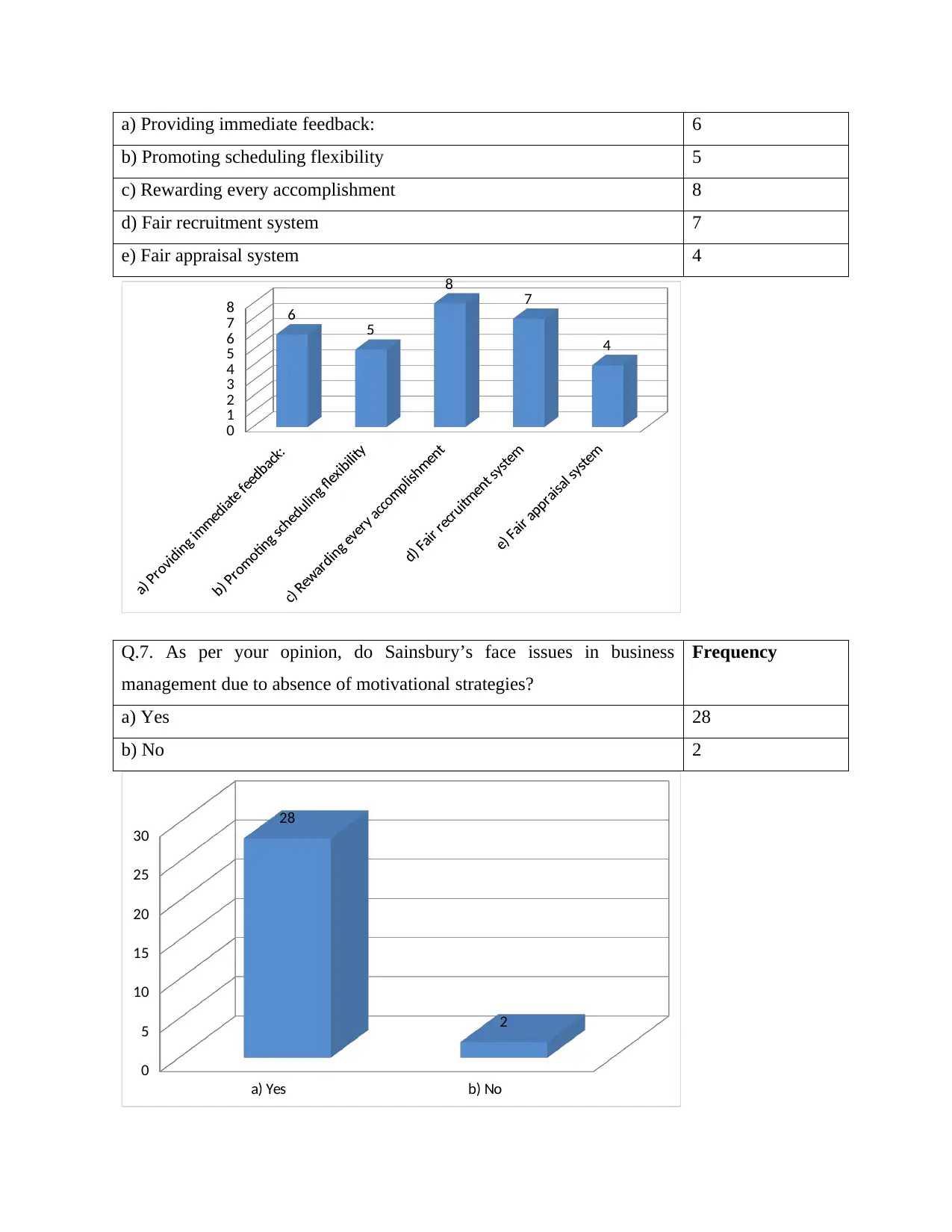
a) Providing immediate feedback: 6
b) Promoting scheduling flexibility 5
c) Rewarding every accomplishment 8
d) Fair recruitment system 7
e) Fair appraisal system 4
0
1
2
3
4
5
6
7
8 6 5
8 7
4
Q.7. As per your opinion, do Sainsbury’s face issues in business
management due to absence of motivational strategies?
Frequency
a) Yes 28
b) No 2
a) Yes b) No
0
5
10
15
20
25
30
28
2
b) Promoting scheduling flexibility 5
c) Rewarding every accomplishment 8
d) Fair recruitment system 7
e) Fair appraisal system 4
0
1
2
3
4
5
6
7
8 6 5
8 7
4
Q.7. As per your opinion, do Sainsbury’s face issues in business
management due to absence of motivational strategies?
Frequency
a) Yes 28
b) No 2
a) Yes b) No
0
5
10
15
20
25
30
28
2
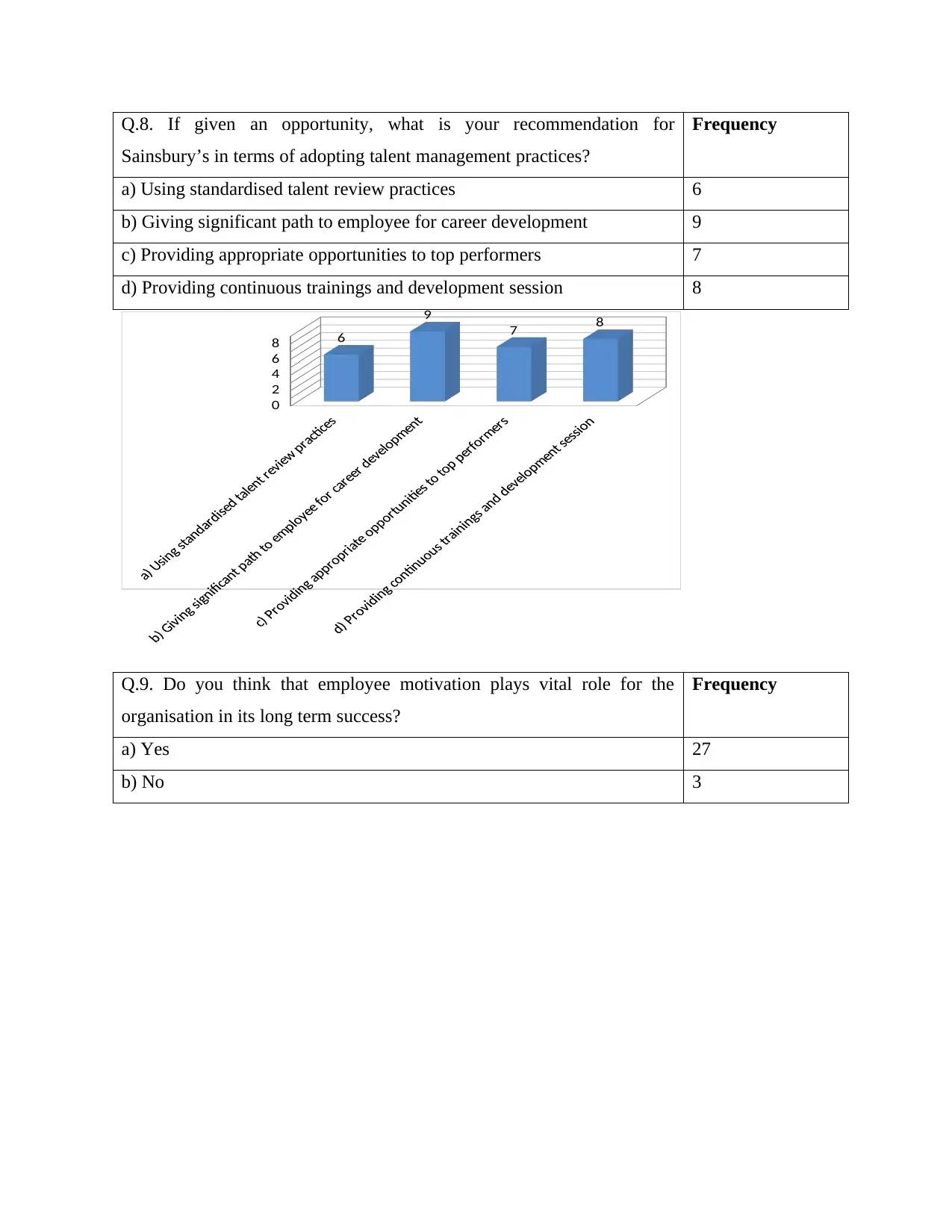
Q.8. If given an opportunity, what is your recommendation for
Sainsbury’s in terms of adopting talent management practices?
Frequency
a) Using standardised talent review practices 6
b) Giving significant path to employee for career development 9
c) Providing appropriate opportunities to top performers 7
d) Providing continuous trainings and development session 8
0
2
4
6
8 6
9
7 8
Q.9. Do you think that employee motivation plays vital role for the
organisation in its long term success?
Frequency
a) Yes 27
b) No 3
Sainsbury’s in terms of adopting talent management practices?
Frequency
a) Using standardised talent review practices 6
b) Giving significant path to employee for career development 9
c) Providing appropriate opportunities to top performers 7
d) Providing continuous trainings and development session 8
0
2
4
6
8 6
9
7 8
Q.9. Do you think that employee motivation plays vital role for the
organisation in its long term success?
Frequency
a) Yes 27
b) No 3
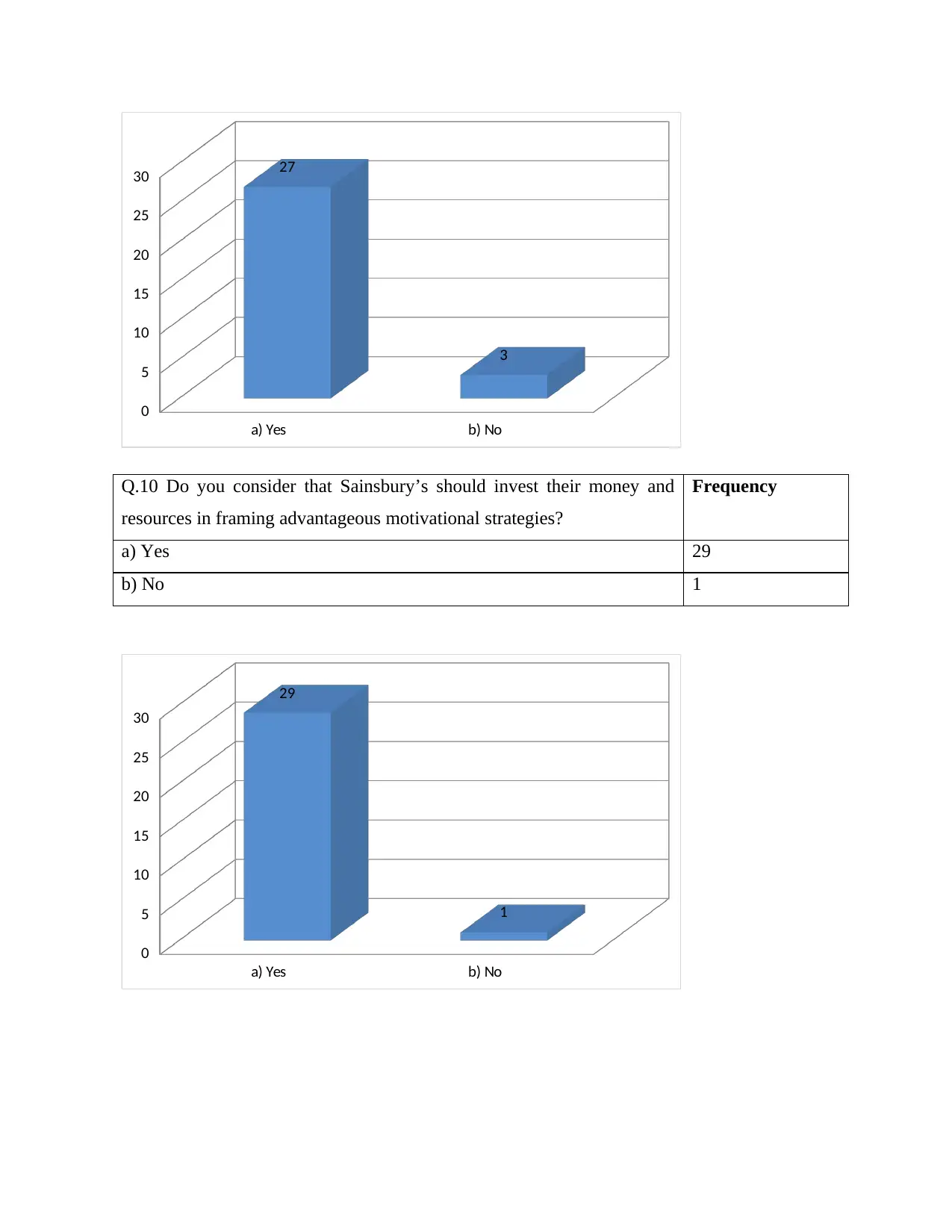
a) Yes b) No
0
5
10
15
20
25
30 27
3
Q.10 Do you consider that Sainsbury’s should invest their money and
resources in framing advantageous motivational strategies?
Frequency
a) Yes 29
b) No 1
a) Yes b) No
0
5
10
15
20
25
30
29
1
0
5
10
15
20
25
30 27
3
Q.10 Do you consider that Sainsbury’s should invest their money and
resources in framing advantageous motivational strategies?
Frequency
a) Yes 29
b) No 1
a) Yes b) No
0
5
10
15
20
25
30
29
1
Paraphrase This Document
Need a fresh take? Get an instant paraphrase of this document with our AI Paraphraser
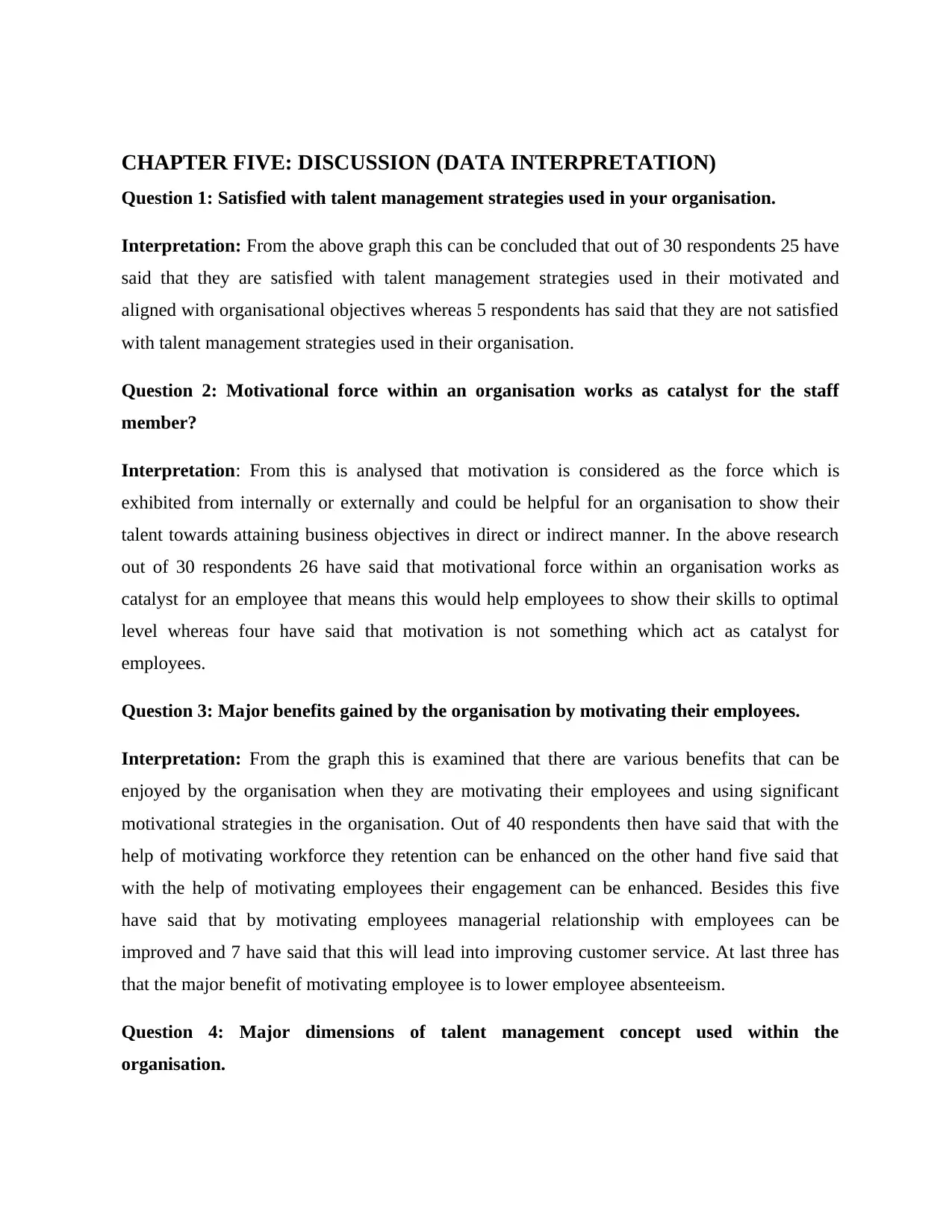
CHAPTER FIVE: DISCUSSION (DATA INTERPRETATION)
Question 1: Satisfied with talent management strategies used in your organisation.
Interpretation: From the above graph this can be concluded that out of 30 respondents 25 have
said that they are satisfied with talent management strategies used in their motivated and
aligned with organisational objectives whereas 5 respondents has said that they are not satisfied
with talent management strategies used in their organisation.
Question 2: Motivational force within an organisation works as catalyst for the staff
member?
Interpretation: From this is analysed that motivation is considered as the force which is
exhibited from internally or externally and could be helpful for an organisation to show their
talent towards attaining business objectives in direct or indirect manner. In the above research
out of 30 respondents 26 have said that motivational force within an organisation works as
catalyst for an employee that means this would help employees to show their skills to optimal
level whereas four have said that motivation is not something which act as catalyst for
employees.
Question 3: Major benefits gained by the organisation by motivating their employees.
Interpretation: From the graph this is examined that there are various benefits that can be
enjoyed by the organisation when they are motivating their employees and using significant
motivational strategies in the organisation. Out of 40 respondents then have said that with the
help of motivating workforce they retention can be enhanced on the other hand five said that
with the help of motivating employees their engagement can be enhanced. Besides this five
have said that by motivating employees managerial relationship with employees can be
improved and 7 have said that this will lead into improving customer service. At last three has
that the major benefit of motivating employee is to lower employee absenteeism.
Question 4: Major dimensions of talent management concept used within the
organisation.
Question 1: Satisfied with talent management strategies used in your organisation.
Interpretation: From the above graph this can be concluded that out of 30 respondents 25 have
said that they are satisfied with talent management strategies used in their motivated and
aligned with organisational objectives whereas 5 respondents has said that they are not satisfied
with talent management strategies used in their organisation.
Question 2: Motivational force within an organisation works as catalyst for the staff
member?
Interpretation: From this is analysed that motivation is considered as the force which is
exhibited from internally or externally and could be helpful for an organisation to show their
talent towards attaining business objectives in direct or indirect manner. In the above research
out of 30 respondents 26 have said that motivational force within an organisation works as
catalyst for an employee that means this would help employees to show their skills to optimal
level whereas four have said that motivation is not something which act as catalyst for
employees.
Question 3: Major benefits gained by the organisation by motivating their employees.
Interpretation: From the graph this is examined that there are various benefits that can be
enjoyed by the organisation when they are motivating their employees and using significant
motivational strategies in the organisation. Out of 40 respondents then have said that with the
help of motivating workforce they retention can be enhanced on the other hand five said that
with the help of motivating employees their engagement can be enhanced. Besides this five
have said that by motivating employees managerial relationship with employees can be
improved and 7 have said that this will lead into improving customer service. At last three has
that the major benefit of motivating employee is to lower employee absenteeism.
Question 4: Major dimensions of talent management concept used within the
organisation.
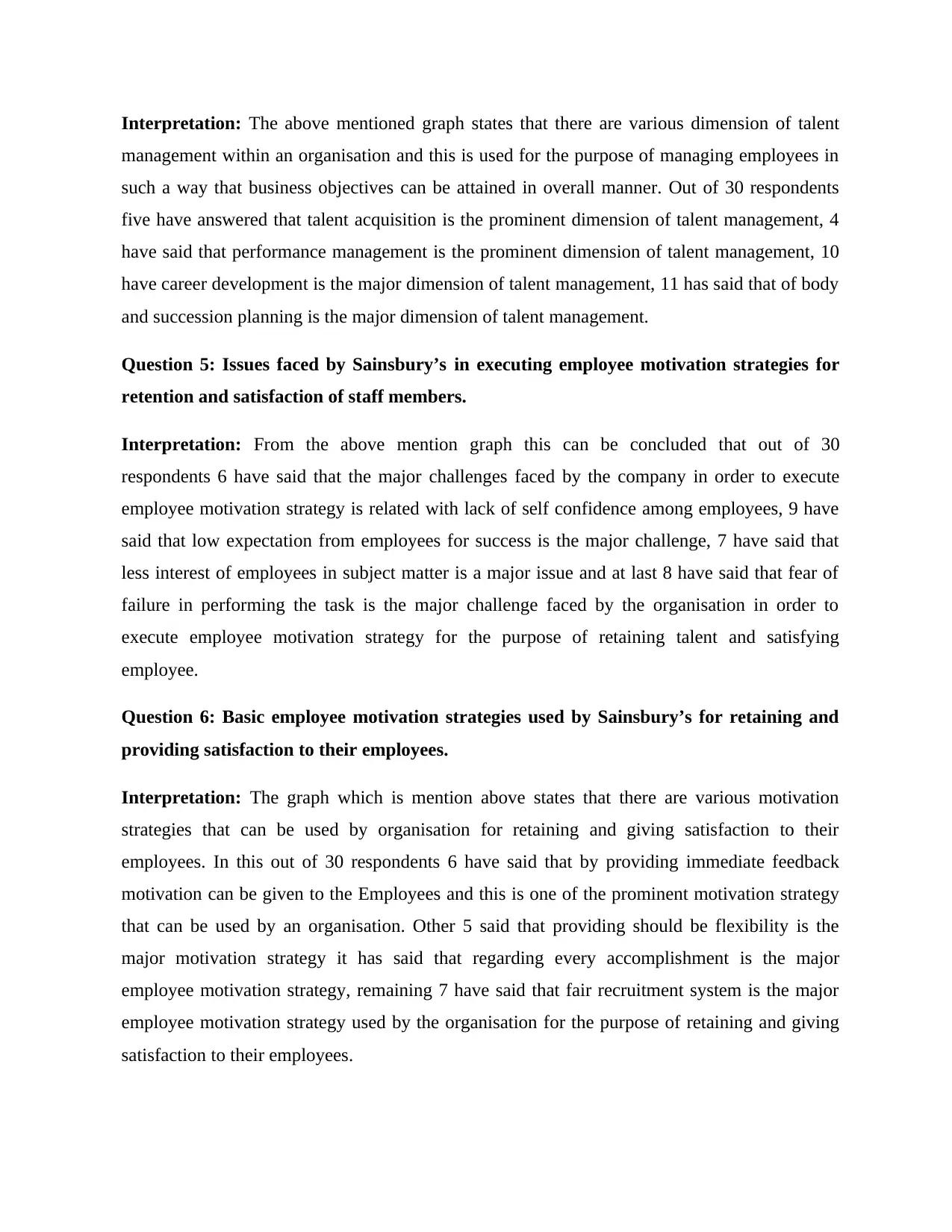
Interpretation: The above mentioned graph states that there are various dimension of talent
management within an organisation and this is used for the purpose of managing employees in
such a way that business objectives can be attained in overall manner. Out of 30 respondents
five have answered that talent acquisition is the prominent dimension of talent management, 4
have said that performance management is the prominent dimension of talent management, 10
have career development is the major dimension of talent management, 11 has said that of body
and succession planning is the major dimension of talent management.
Question 5: Issues faced by Sainsbury’s in executing employee motivation strategies for
retention and satisfaction of staff members.
Interpretation: From the above mention graph this can be concluded that out of 30
respondents 6 have said that the major challenges faced by the company in order to execute
employee motivation strategy is related with lack of self confidence among employees, 9 have
said that low expectation from employees for success is the major challenge, 7 have said that
less interest of employees in subject matter is a major issue and at last 8 have said that fear of
failure in performing the task is the major challenge faced by the organisation in order to
execute employee motivation strategy for the purpose of retaining talent and satisfying
employee.
Question 6: Basic employee motivation strategies used by Sainsbury’s for retaining and
providing satisfaction to their employees.
Interpretation: The graph which is mention above states that there are various motivation
strategies that can be used by organisation for retaining and giving satisfaction to their
employees. In this out of 30 respondents 6 have said that by providing immediate feedback
motivation can be given to the Employees and this is one of the prominent motivation strategy
that can be used by an organisation. Other 5 said that providing should be flexibility is the
major motivation strategy it has said that regarding every accomplishment is the major
employee motivation strategy, remaining 7 have said that fair recruitment system is the major
employee motivation strategy used by the organisation for the purpose of retaining and giving
satisfaction to their employees.
management within an organisation and this is used for the purpose of managing employees in
such a way that business objectives can be attained in overall manner. Out of 30 respondents
five have answered that talent acquisition is the prominent dimension of talent management, 4
have said that performance management is the prominent dimension of talent management, 10
have career development is the major dimension of talent management, 11 has said that of body
and succession planning is the major dimension of talent management.
Question 5: Issues faced by Sainsbury’s in executing employee motivation strategies for
retention and satisfaction of staff members.
Interpretation: From the above mention graph this can be concluded that out of 30
respondents 6 have said that the major challenges faced by the company in order to execute
employee motivation strategy is related with lack of self confidence among employees, 9 have
said that low expectation from employees for success is the major challenge, 7 have said that
less interest of employees in subject matter is a major issue and at last 8 have said that fear of
failure in performing the task is the major challenge faced by the organisation in order to
execute employee motivation strategy for the purpose of retaining talent and satisfying
employee.
Question 6: Basic employee motivation strategies used by Sainsbury’s for retaining and
providing satisfaction to their employees.
Interpretation: The graph which is mention above states that there are various motivation
strategies that can be used by organisation for retaining and giving satisfaction to their
employees. In this out of 30 respondents 6 have said that by providing immediate feedback
motivation can be given to the Employees and this is one of the prominent motivation strategy
that can be used by an organisation. Other 5 said that providing should be flexibility is the
major motivation strategy it has said that regarding every accomplishment is the major
employee motivation strategy, remaining 7 have said that fair recruitment system is the major
employee motivation strategy used by the organisation for the purpose of retaining and giving
satisfaction to their employees.
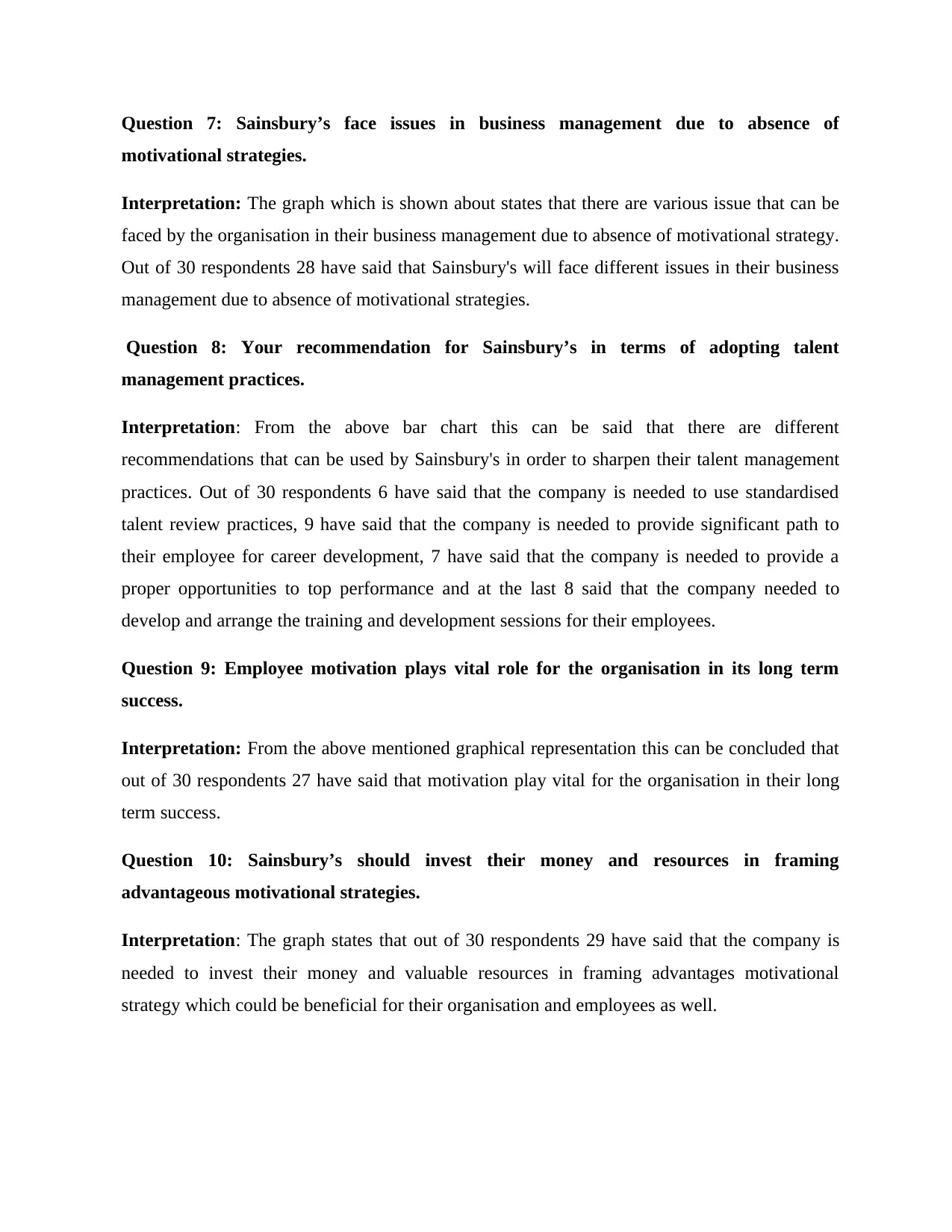
Question 7: Sainsbury’s face issues in business management due to absence of
motivational strategies.
Interpretation: The graph which is shown about states that there are various issue that can be
faced by the organisation in their business management due to absence of motivational strategy.
Out of 30 respondents 28 have said that Sainsbury's will face different issues in their business
management due to absence of motivational strategies.
Question 8: Your recommendation for Sainsbury’s in terms of adopting talent
management practices.
Interpretation: From the above bar chart this can be said that there are different
recommendations that can be used by Sainsbury's in order to sharpen their talent management
practices. Out of 30 respondents 6 have said that the company is needed to use standardised
talent review practices, 9 have said that the company is needed to provide significant path to
their employee for career development, 7 have said that the company is needed to provide a
proper opportunities to top performance and at the last 8 said that the company needed to
develop and arrange the training and development sessions for their employees.
Question 9: Employee motivation plays vital role for the organisation in its long term
success.
Interpretation: From the above mentioned graphical representation this can be concluded that
out of 30 respondents 27 have said that motivation play vital for the organisation in their long
term success.
Question 10: Sainsbury’s should invest their money and resources in framing
advantageous motivational strategies.
Interpretation: The graph states that out of 30 respondents 29 have said that the company is
needed to invest their money and valuable resources in framing advantages motivational
strategy which could be beneficial for their organisation and employees as well.
motivational strategies.
Interpretation: The graph which is shown about states that there are various issue that can be
faced by the organisation in their business management due to absence of motivational strategy.
Out of 30 respondents 28 have said that Sainsbury's will face different issues in their business
management due to absence of motivational strategies.
Question 8: Your recommendation for Sainsbury’s in terms of adopting talent
management practices.
Interpretation: From the above bar chart this can be said that there are different
recommendations that can be used by Sainsbury's in order to sharpen their talent management
practices. Out of 30 respondents 6 have said that the company is needed to use standardised
talent review practices, 9 have said that the company is needed to provide significant path to
their employee for career development, 7 have said that the company is needed to provide a
proper opportunities to top performance and at the last 8 said that the company needed to
develop and arrange the training and development sessions for their employees.
Question 9: Employee motivation plays vital role for the organisation in its long term
success.
Interpretation: From the above mentioned graphical representation this can be concluded that
out of 30 respondents 27 have said that motivation play vital for the organisation in their long
term success.
Question 10: Sainsbury’s should invest their money and resources in framing
advantageous motivational strategies.
Interpretation: The graph states that out of 30 respondents 29 have said that the company is
needed to invest their money and valuable resources in framing advantages motivational
strategy which could be beneficial for their organisation and employees as well.
Secure Best Marks with AI Grader
Need help grading? Try our AI Grader for instant feedback on your assignments.
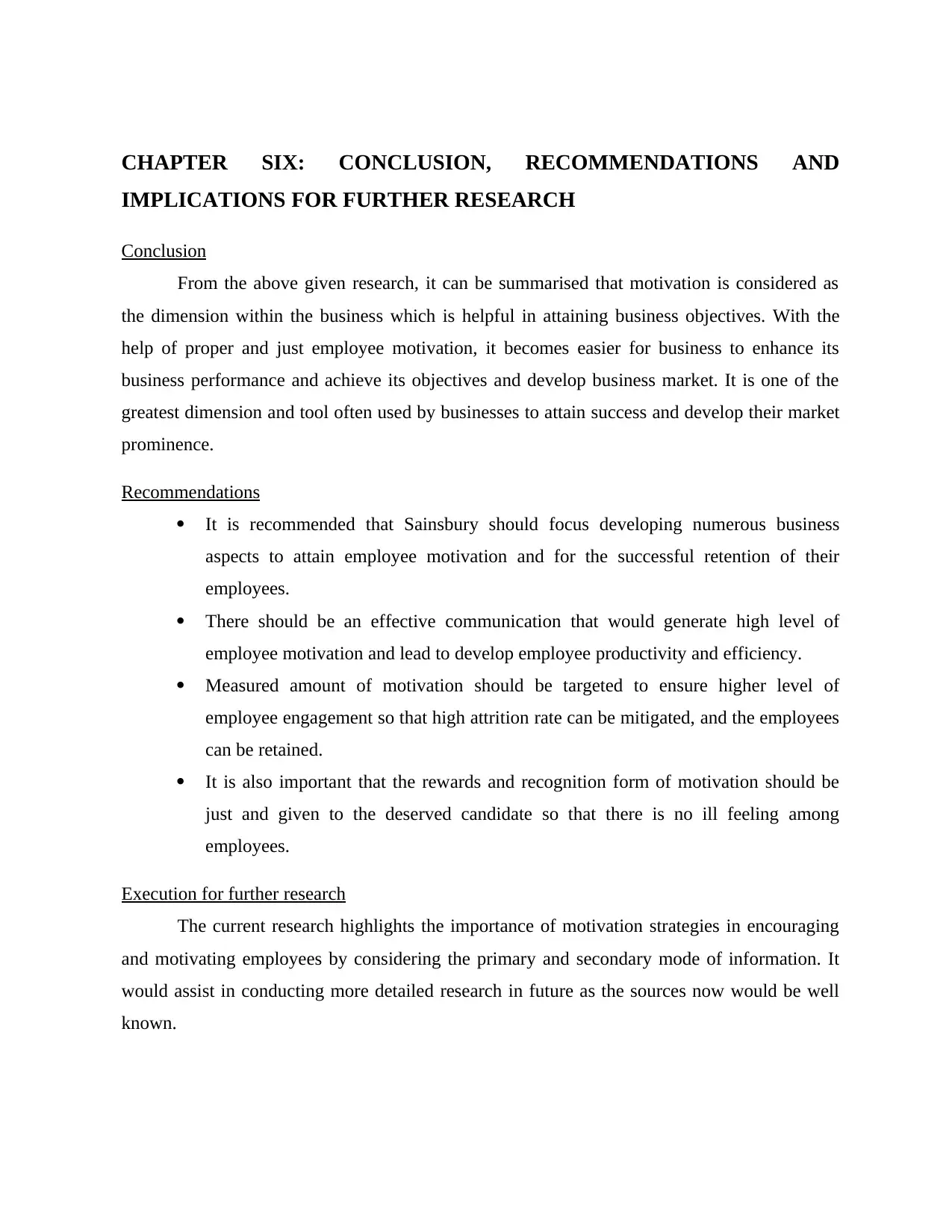
CHAPTER SIX: CONCLUSION, RECOMMENDATIONS AND
IMPLICATIONS FOR FURTHER RESEARCH
Conclusion
From the above given research, it can be summarised that motivation is considered as
the dimension within the business which is helpful in attaining business objectives. With the
help of proper and just employee motivation, it becomes easier for business to enhance its
business performance and achieve its objectives and develop business market. It is one of the
greatest dimension and tool often used by businesses to attain success and develop their market
prominence.
Recommendations
It is recommended that Sainsbury should focus developing numerous business
aspects to attain employee motivation and for the successful retention of their
employees.
There should be an effective communication that would generate high level of
employee motivation and lead to develop employee productivity and efficiency.
Measured amount of motivation should be targeted to ensure higher level of
employee engagement so that high attrition rate can be mitigated, and the employees
can be retained.
It is also important that the rewards and recognition form of motivation should be
just and given to the deserved candidate so that there is no ill feeling among
employees.
Execution for further research
The current research highlights the importance of motivation strategies in encouraging
and motivating employees by considering the primary and secondary mode of information. It
would assist in conducting more detailed research in future as the sources now would be well
known.
IMPLICATIONS FOR FURTHER RESEARCH
Conclusion
From the above given research, it can be summarised that motivation is considered as
the dimension within the business which is helpful in attaining business objectives. With the
help of proper and just employee motivation, it becomes easier for business to enhance its
business performance and achieve its objectives and develop business market. It is one of the
greatest dimension and tool often used by businesses to attain success and develop their market
prominence.
Recommendations
It is recommended that Sainsbury should focus developing numerous business
aspects to attain employee motivation and for the successful retention of their
employees.
There should be an effective communication that would generate high level of
employee motivation and lead to develop employee productivity and efficiency.
Measured amount of motivation should be targeted to ensure higher level of
employee engagement so that high attrition rate can be mitigated, and the employees
can be retained.
It is also important that the rewards and recognition form of motivation should be
just and given to the deserved candidate so that there is no ill feeling among
employees.
Execution for further research
The current research highlights the importance of motivation strategies in encouraging
and motivating employees by considering the primary and secondary mode of information. It
would assist in conducting more detailed research in future as the sources now would be well
known.

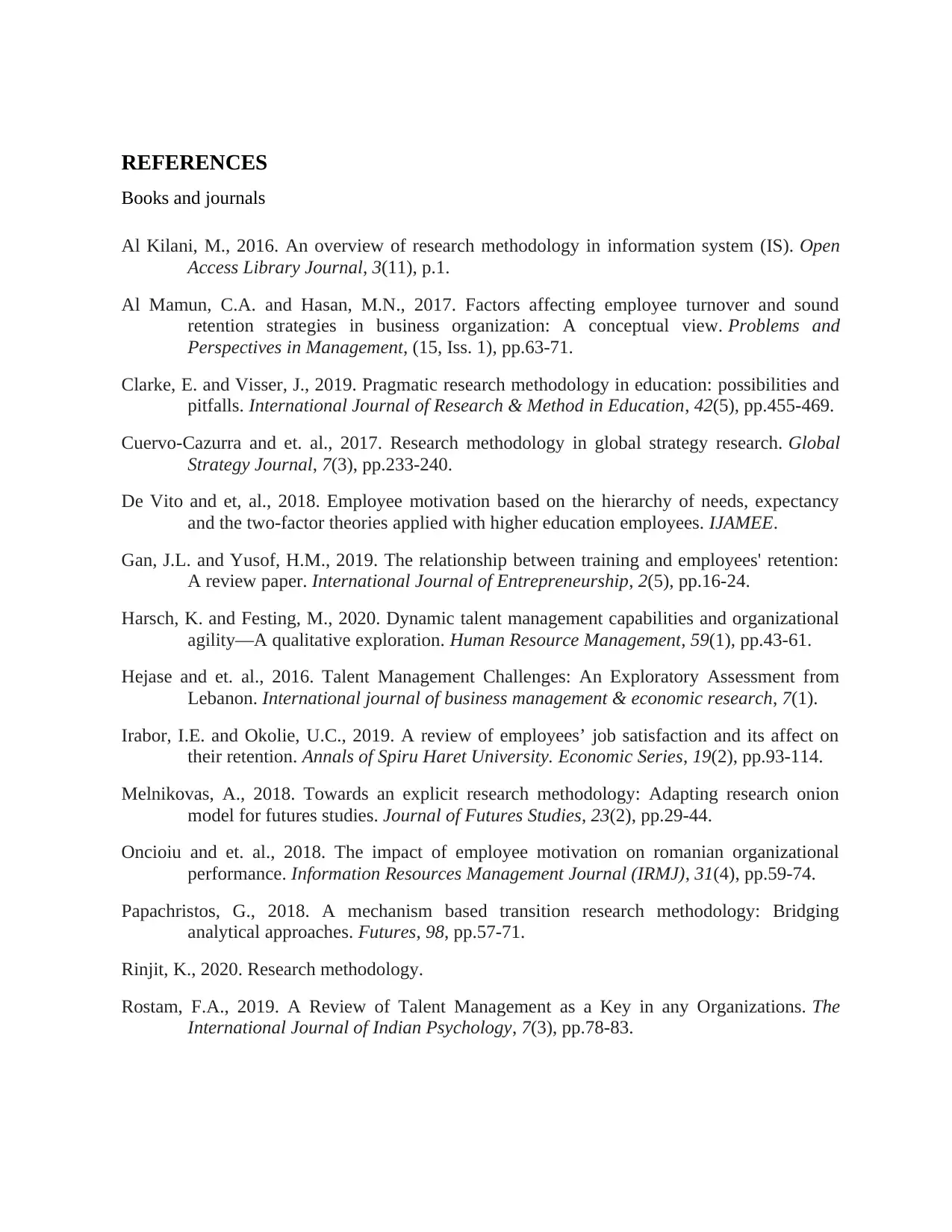
REFERENCES
Books and journals
Al Kilani, M., 2016. An overview of research methodology in information system (IS). Open
Access Library Journal, 3(11), p.1.
Al Mamun, C.A. and Hasan, M.N., 2017. Factors affecting employee turnover and sound
retention strategies in business organization: A conceptual view. Problems and
Perspectives in Management, (15, Iss. 1), pp.63-71.
Clarke, E. and Visser, J., 2019. Pragmatic research methodology in education: possibilities and
pitfalls. International Journal of Research & Method in Education, 42(5), pp.455-469.
Cuervo‐Cazurra and et. al., 2017. Research methodology in global strategy research. Global
Strategy Journal, 7(3), pp.233-240.
De Vito and et, al., 2018. Employee motivation based on the hierarchy of needs, expectancy
and the two-factor theories applied with higher education employees. IJAMEE.
Gan, J.L. and Yusof, H.M., 2019. The relationship between training and employees' retention:
A review paper. International Journal of Entrepreneurship, 2(5), pp.16-24.
Harsch, K. and Festing, M., 2020. Dynamic talent management capabilities and organizational
agility—A qualitative exploration. Human Resource Management, 59(1), pp.43-61.
Hejase and et. al., 2016. Talent Management Challenges: An Exploratory Assessment from
Lebanon. International journal of business management & economic research, 7(1).
Irabor, I.E. and Okolie, U.C., 2019. A review of employees’ job satisfaction and its affect on
their retention. Annals of Spiru Haret University. Economic Series, 19(2), pp.93-114.
Melnikovas, A., 2018. Towards an explicit research methodology: Adapting research onion
model for futures studies. Journal of Futures Studies, 23(2), pp.29-44.
Oncioiu and et. al., 2018. The impact of employee motivation on romanian organizational
performance. Information Resources Management Journal (IRMJ), 31(4), pp.59-74.
Papachristos, G., 2018. A mechanism based transition research methodology: Bridging
analytical approaches. Futures, 98, pp.57-71.
Rinjit, K., 2020. Research methodology.
Rostam, F.A., 2019. A Review of Talent Management as a Key in any Organizations. The
International Journal of Indian Psychology, 7(3), pp.78-83.
Books and journals
Al Kilani, M., 2016. An overview of research methodology in information system (IS). Open
Access Library Journal, 3(11), p.1.
Al Mamun, C.A. and Hasan, M.N., 2017. Factors affecting employee turnover and sound
retention strategies in business organization: A conceptual view. Problems and
Perspectives in Management, (15, Iss. 1), pp.63-71.
Clarke, E. and Visser, J., 2019. Pragmatic research methodology in education: possibilities and
pitfalls. International Journal of Research & Method in Education, 42(5), pp.455-469.
Cuervo‐Cazurra and et. al., 2017. Research methodology in global strategy research. Global
Strategy Journal, 7(3), pp.233-240.
De Vito and et, al., 2018. Employee motivation based on the hierarchy of needs, expectancy
and the two-factor theories applied with higher education employees. IJAMEE.
Gan, J.L. and Yusof, H.M., 2019. The relationship between training and employees' retention:
A review paper. International Journal of Entrepreneurship, 2(5), pp.16-24.
Harsch, K. and Festing, M., 2020. Dynamic talent management capabilities and organizational
agility—A qualitative exploration. Human Resource Management, 59(1), pp.43-61.
Hejase and et. al., 2016. Talent Management Challenges: An Exploratory Assessment from
Lebanon. International journal of business management & economic research, 7(1).
Irabor, I.E. and Okolie, U.C., 2019. A review of employees’ job satisfaction and its affect on
their retention. Annals of Spiru Haret University. Economic Series, 19(2), pp.93-114.
Melnikovas, A., 2018. Towards an explicit research methodology: Adapting research onion
model for futures studies. Journal of Futures Studies, 23(2), pp.29-44.
Oncioiu and et. al., 2018. The impact of employee motivation on romanian organizational
performance. Information Resources Management Journal (IRMJ), 31(4), pp.59-74.
Papachristos, G., 2018. A mechanism based transition research methodology: Bridging
analytical approaches. Futures, 98, pp.57-71.
Rinjit, K., 2020. Research methodology.
Rostam, F.A., 2019. A Review of Talent Management as a Key in any Organizations. The
International Journal of Indian Psychology, 7(3), pp.78-83.
Paraphrase This Document
Need a fresh take? Get an instant paraphrase of this document with our AI Paraphraser
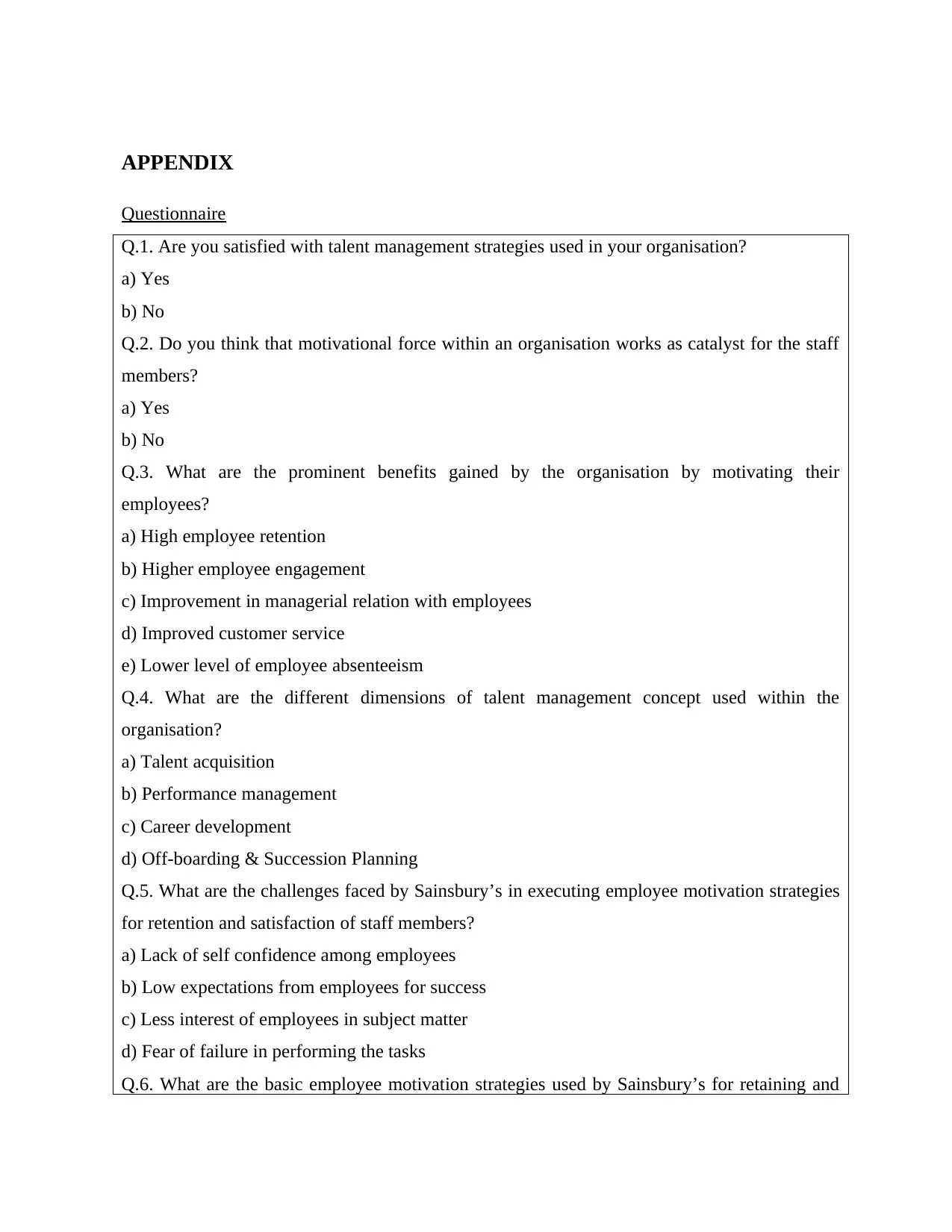
APPENDIX
Questionnaire
Q.1. Are you satisfied with talent management strategies used in your organisation?
a) Yes
b) No
Q.2. Do you think that motivational force within an organisation works as catalyst for the staff
members?
a) Yes
b) No
Q.3. What are the prominent benefits gained by the organisation by motivating their
employees?
a) High employee retention
b) Higher employee engagement
c) Improvement in managerial relation with employees
d) Improved customer service
e) Lower level of employee absenteeism
Q.4. What are the different dimensions of talent management concept used within the
organisation?
a) Talent acquisition
b) Performance management
c) Career development
d) Off-boarding & Succession Planning
Q.5. What are the challenges faced by Sainsbury’s in executing employee motivation strategies
for retention and satisfaction of staff members?
a) Lack of self confidence among employees
b) Low expectations from employees for success
c) Less interest of employees in subject matter
d) Fear of failure in performing the tasks
Q.6. What are the basic employee motivation strategies used by Sainsbury’s for retaining and
Questionnaire
Q.1. Are you satisfied with talent management strategies used in your organisation?
a) Yes
b) No
Q.2. Do you think that motivational force within an organisation works as catalyst for the staff
members?
a) Yes
b) No
Q.3. What are the prominent benefits gained by the organisation by motivating their
employees?
a) High employee retention
b) Higher employee engagement
c) Improvement in managerial relation with employees
d) Improved customer service
e) Lower level of employee absenteeism
Q.4. What are the different dimensions of talent management concept used within the
organisation?
a) Talent acquisition
b) Performance management
c) Career development
d) Off-boarding & Succession Planning
Q.5. What are the challenges faced by Sainsbury’s in executing employee motivation strategies
for retention and satisfaction of staff members?
a) Lack of self confidence among employees
b) Low expectations from employees for success
c) Less interest of employees in subject matter
d) Fear of failure in performing the tasks
Q.6. What are the basic employee motivation strategies used by Sainsbury’s for retaining and
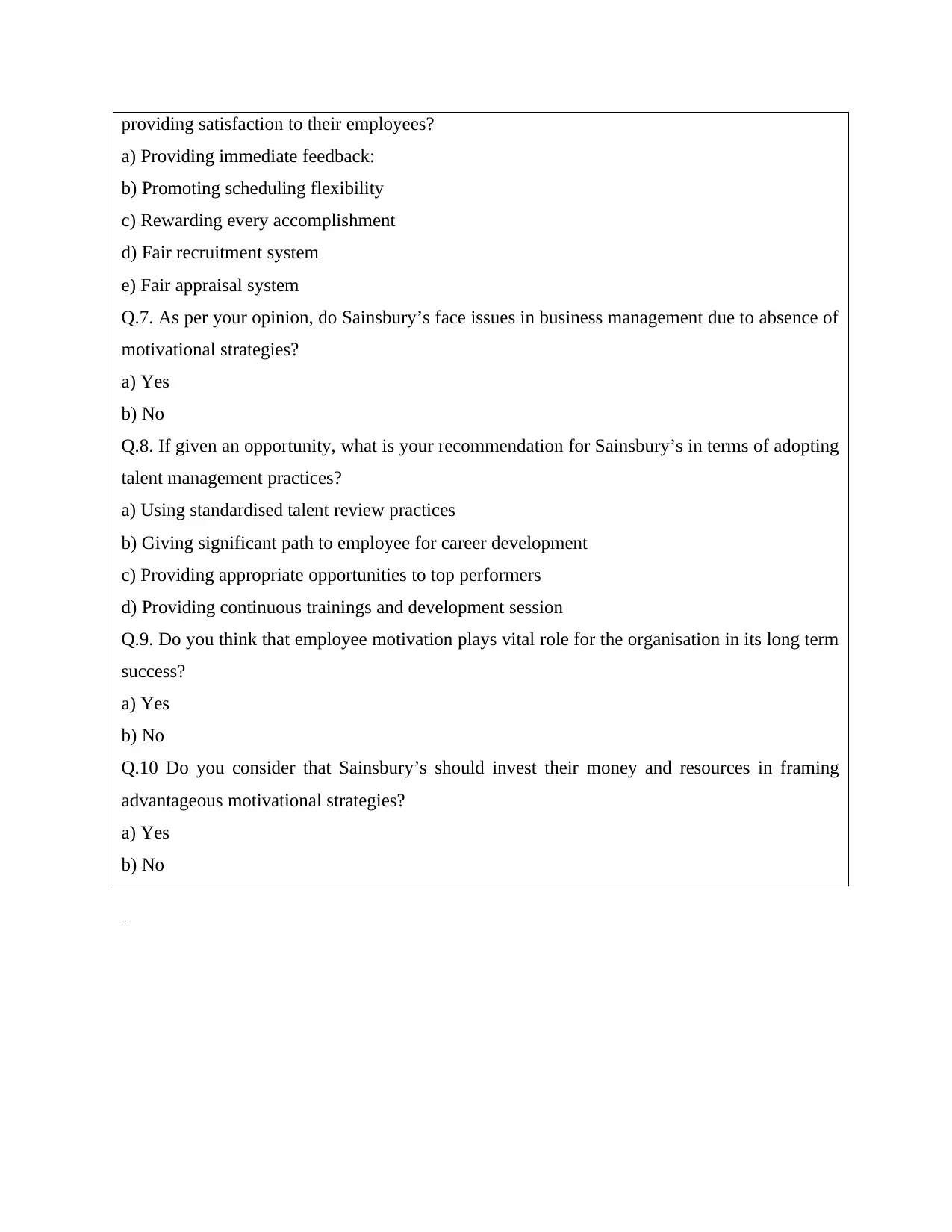
providing satisfaction to their employees?
a) Providing immediate feedback:
b) Promoting scheduling flexibility
c) Rewarding every accomplishment
d) Fair recruitment system
e) Fair appraisal system
Q.7. As per your opinion, do Sainsbury’s face issues in business management due to absence of
motivational strategies?
a) Yes
b) No
Q.8. If given an opportunity, what is your recommendation for Sainsbury’s in terms of adopting
talent management practices?
a) Using standardised talent review practices
b) Giving significant path to employee for career development
c) Providing appropriate opportunities to top performers
d) Providing continuous trainings and development session
Q.9. Do you think that employee motivation plays vital role for the organisation in its long term
success?
a) Yes
b) No
Q.10 Do you consider that Sainsbury’s should invest their money and resources in framing
advantageous motivational strategies?
a) Yes
b) No
a) Providing immediate feedback:
b) Promoting scheduling flexibility
c) Rewarding every accomplishment
d) Fair recruitment system
e) Fair appraisal system
Q.7. As per your opinion, do Sainsbury’s face issues in business management due to absence of
motivational strategies?
a) Yes
b) No
Q.8. If given an opportunity, what is your recommendation for Sainsbury’s in terms of adopting
talent management practices?
a) Using standardised talent review practices
b) Giving significant path to employee for career development
c) Providing appropriate opportunities to top performers
d) Providing continuous trainings and development session
Q.9. Do you think that employee motivation plays vital role for the organisation in its long term
success?
a) Yes
b) No
Q.10 Do you consider that Sainsbury’s should invest their money and resources in framing
advantageous motivational strategies?
a) Yes
b) No
1 out of 27
Your All-in-One AI-Powered Toolkit for Academic Success.
+13062052269
info@desklib.com
Available 24*7 on WhatsApp / Email
![[object Object]](/_next/static/media/star-bottom.7253800d.svg)
Unlock your academic potential
© 2024 | Zucol Services PVT LTD | All rights reserved.



